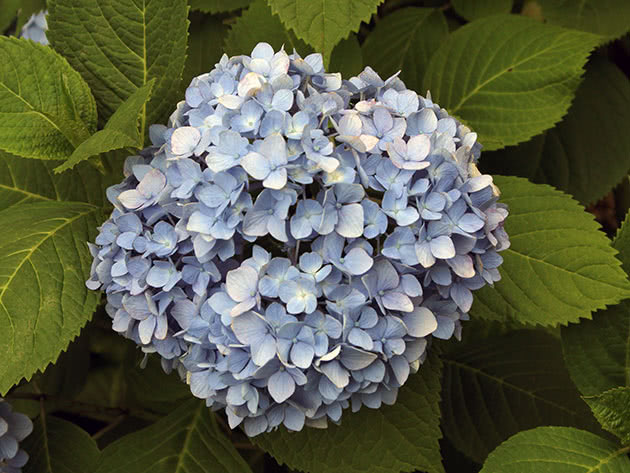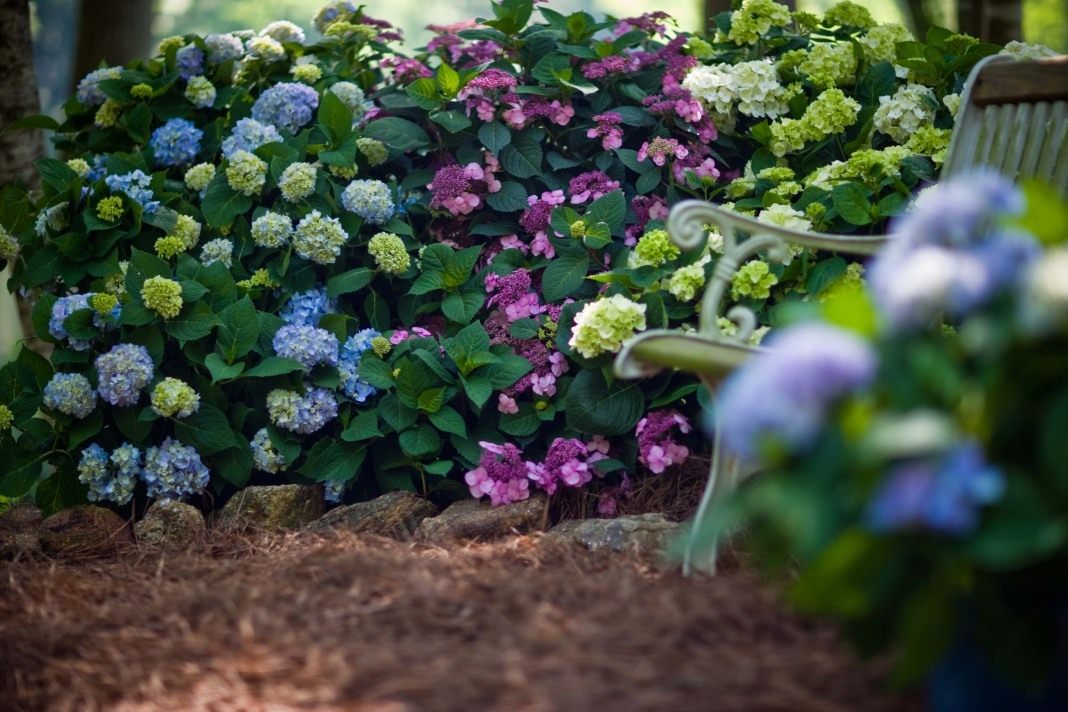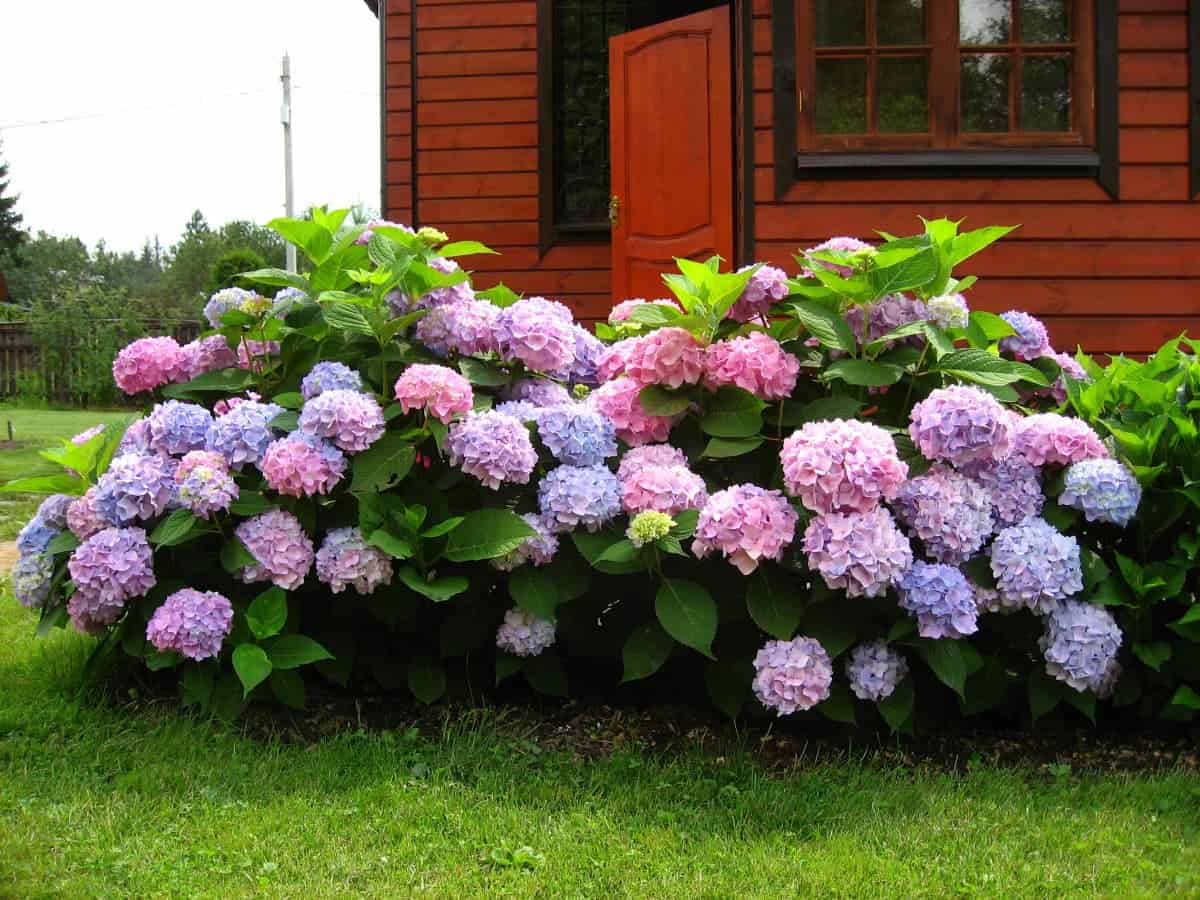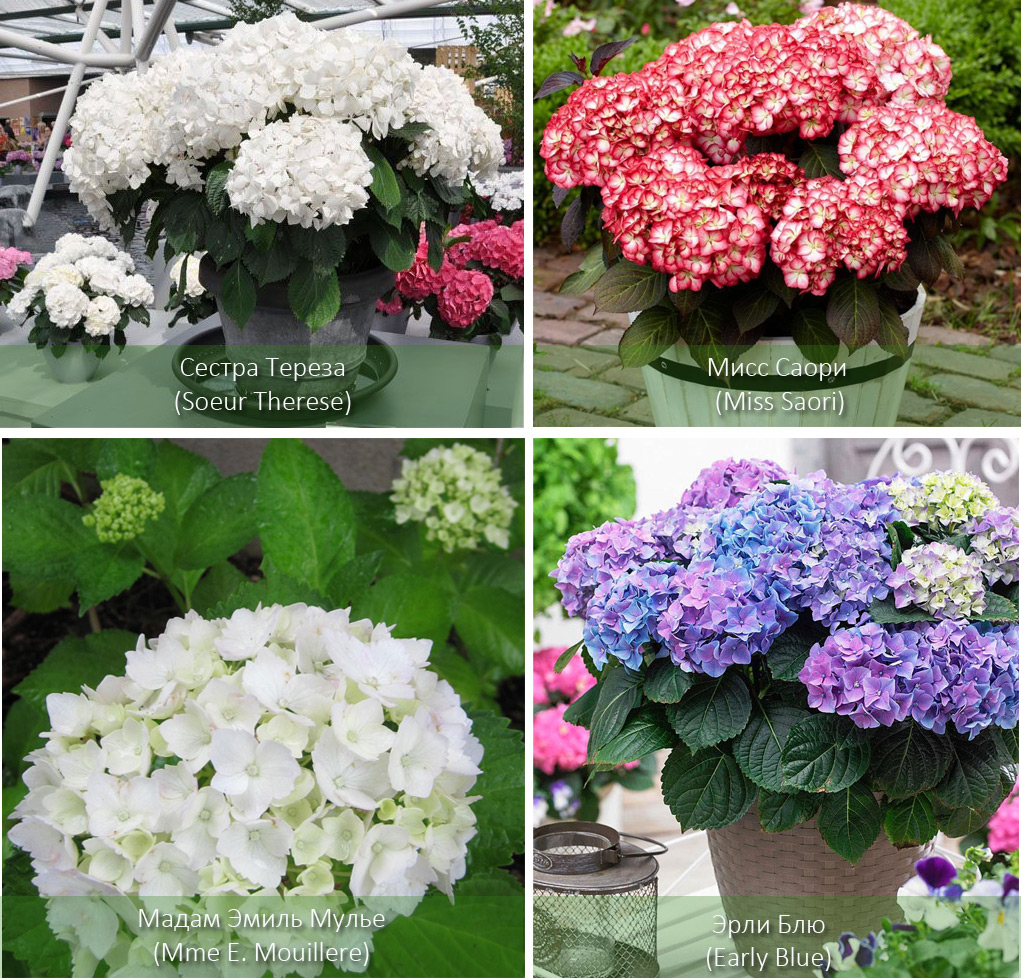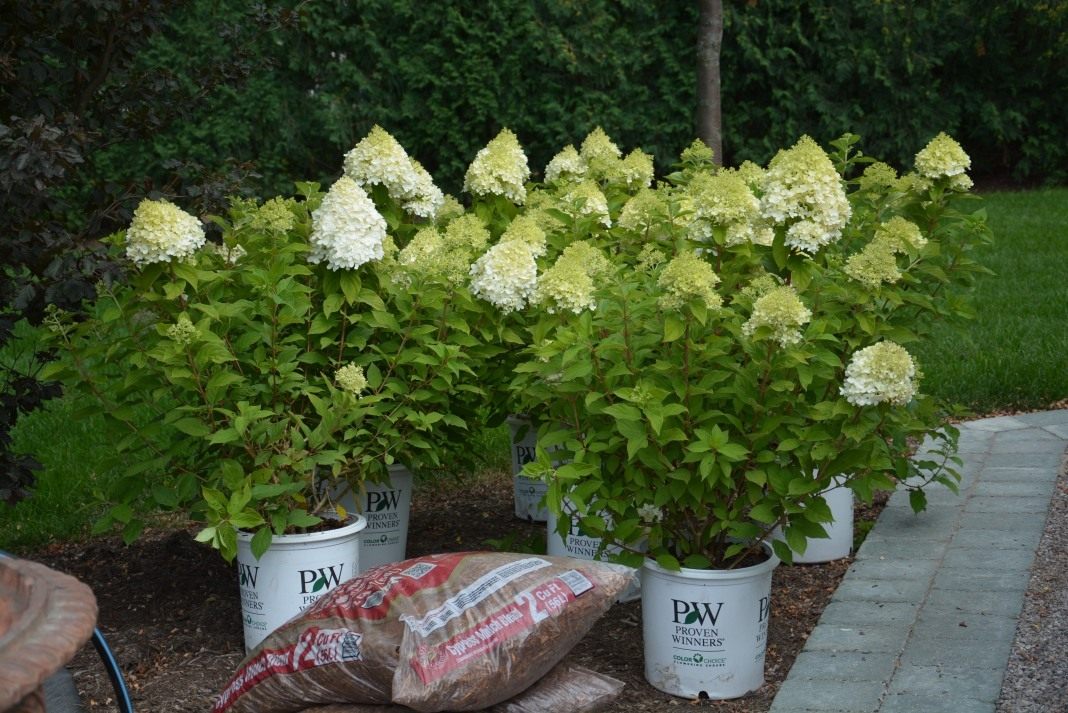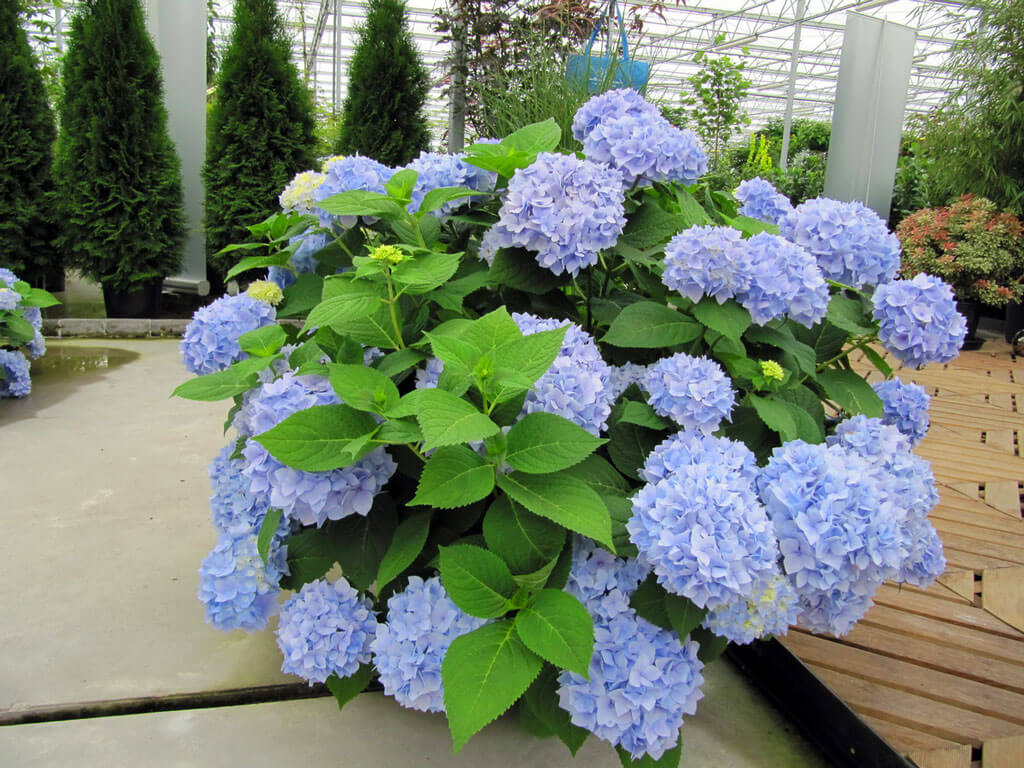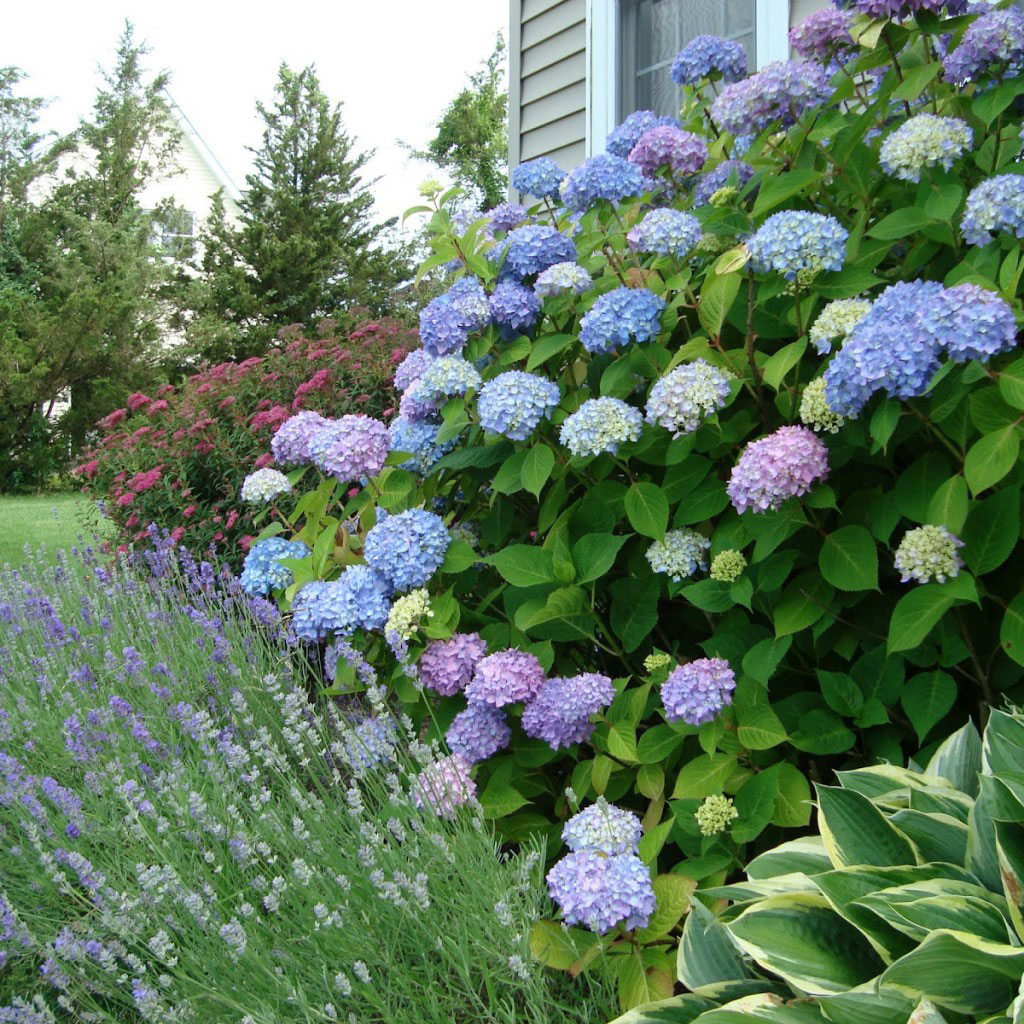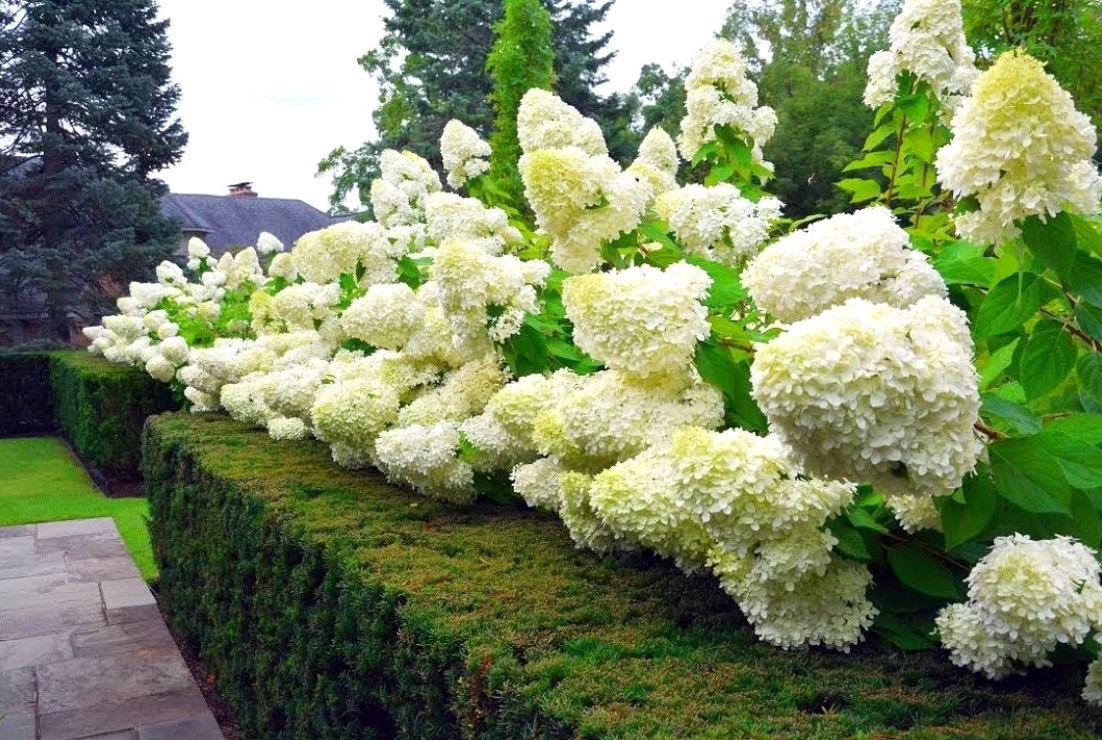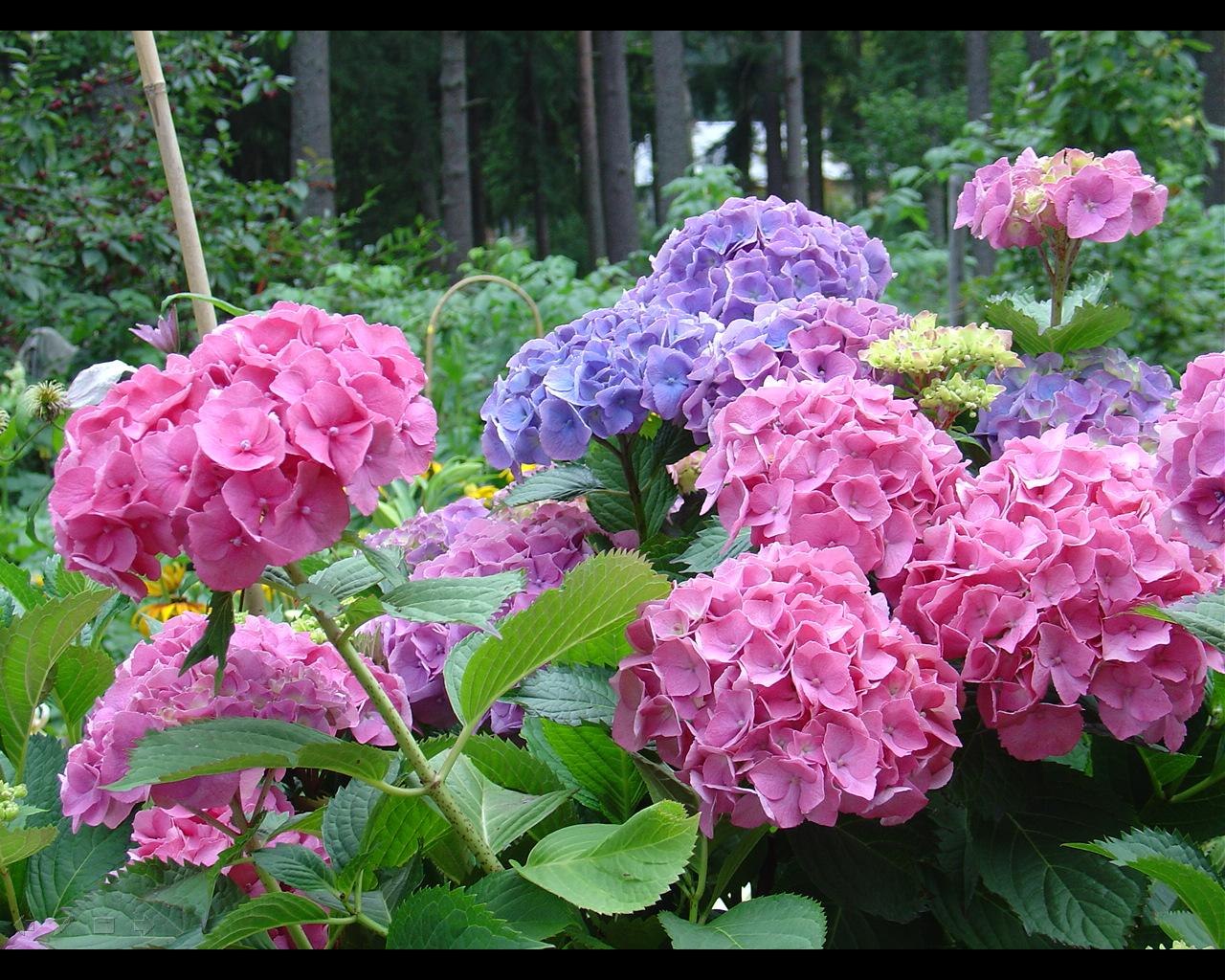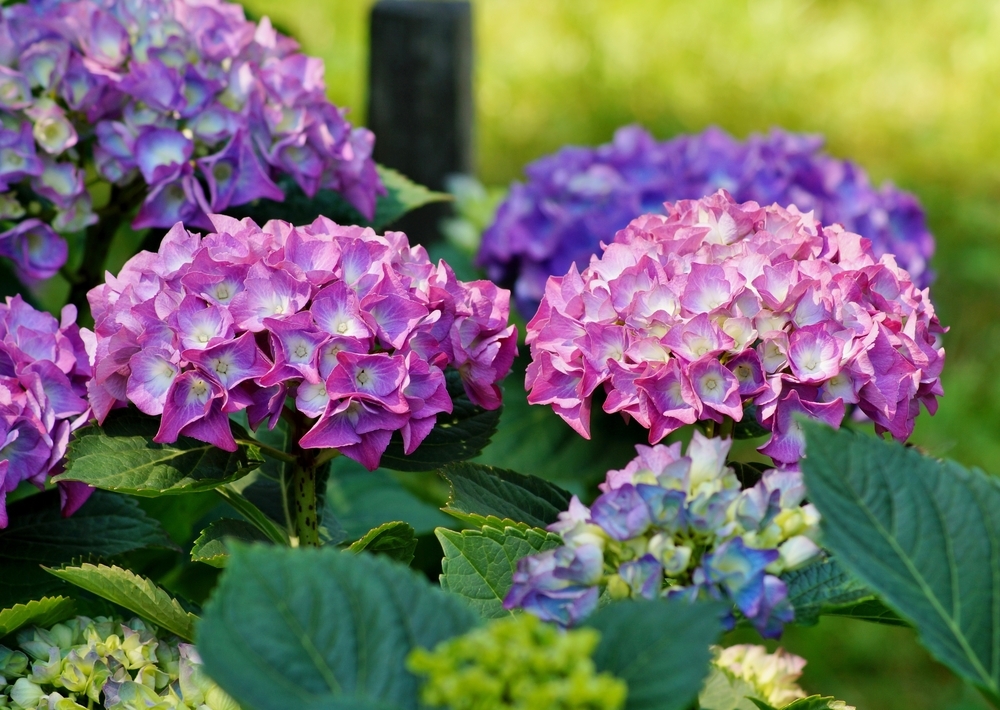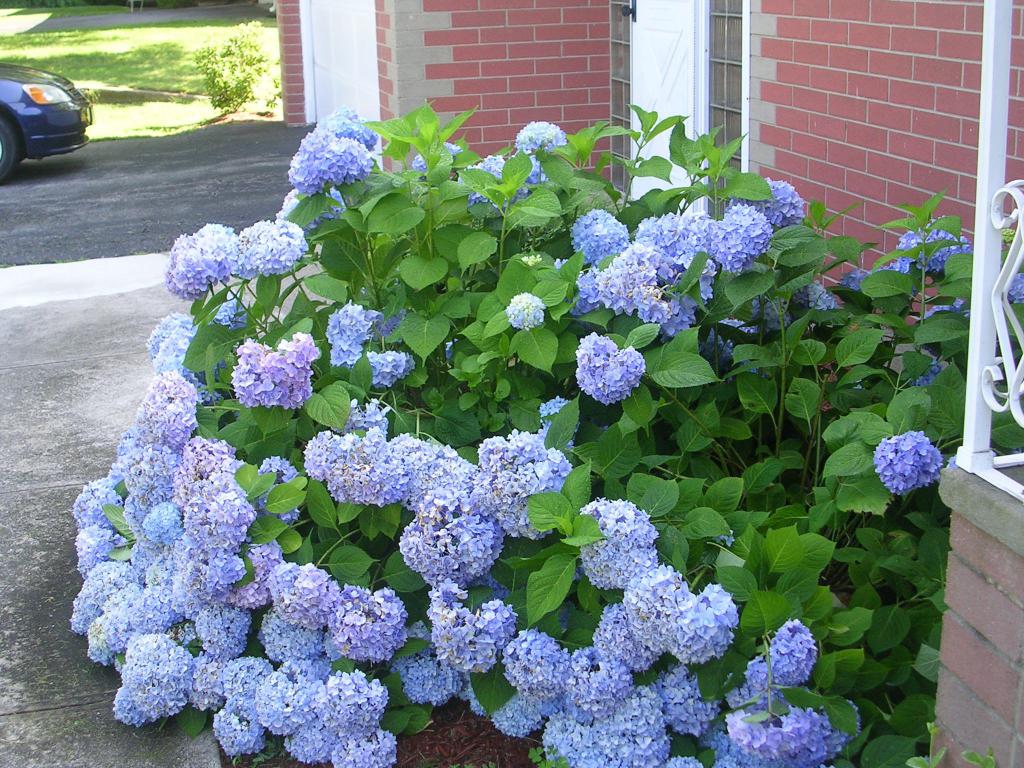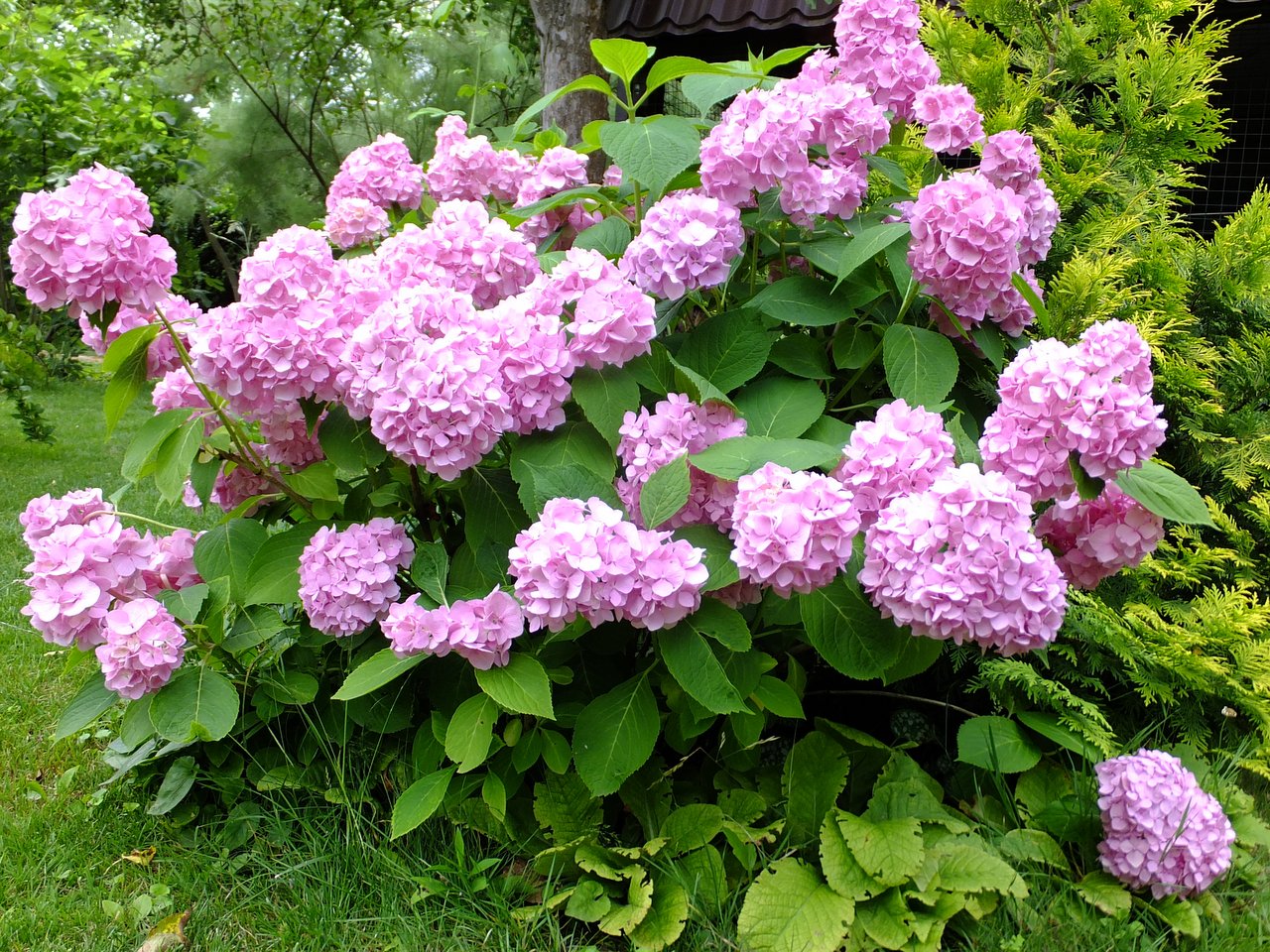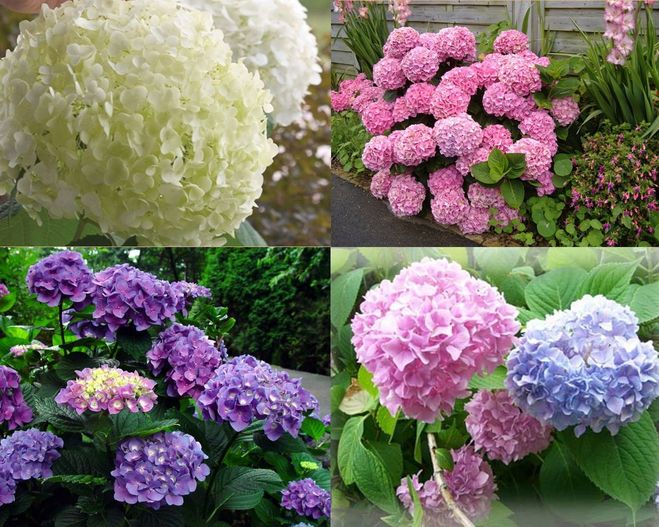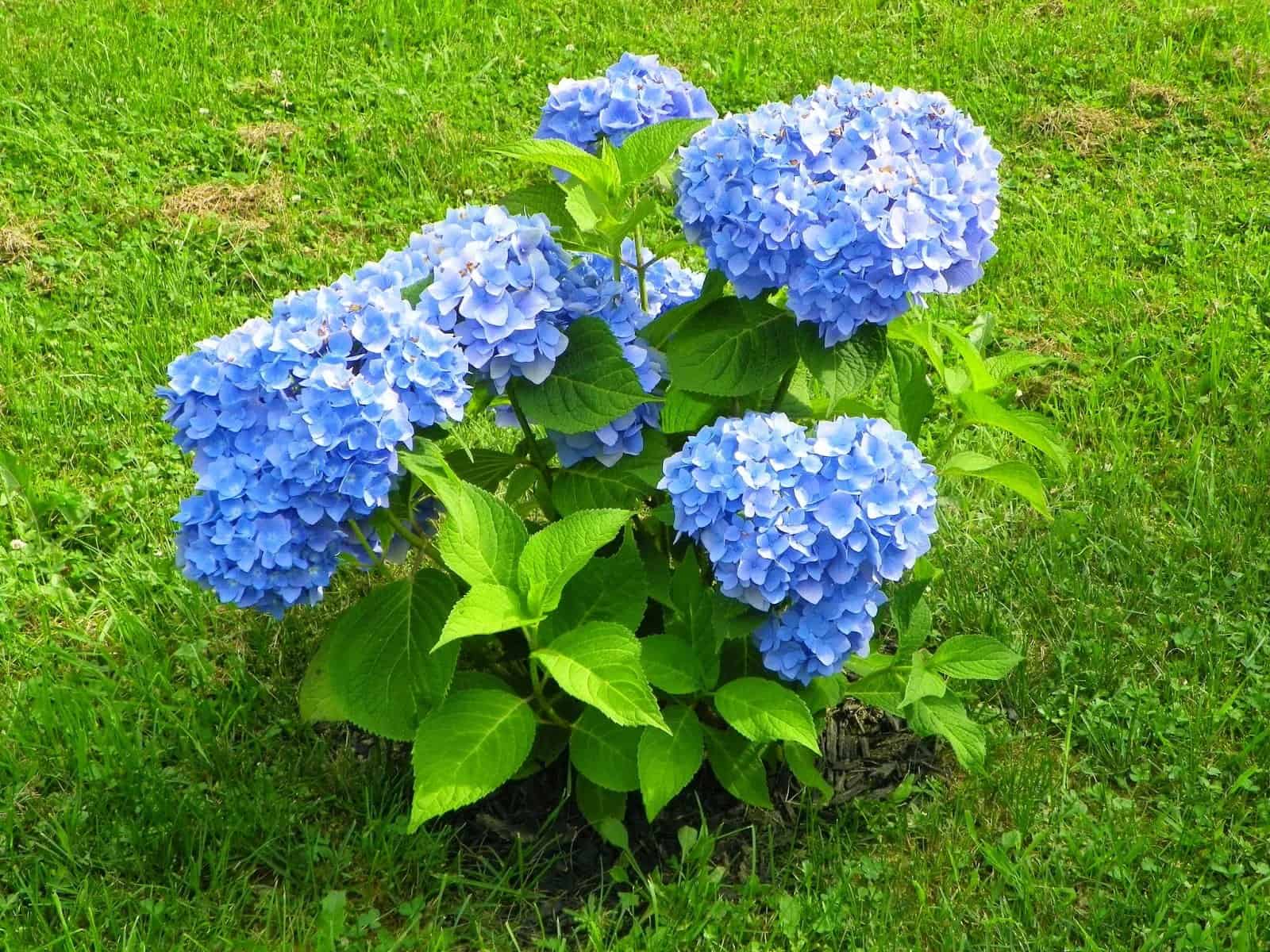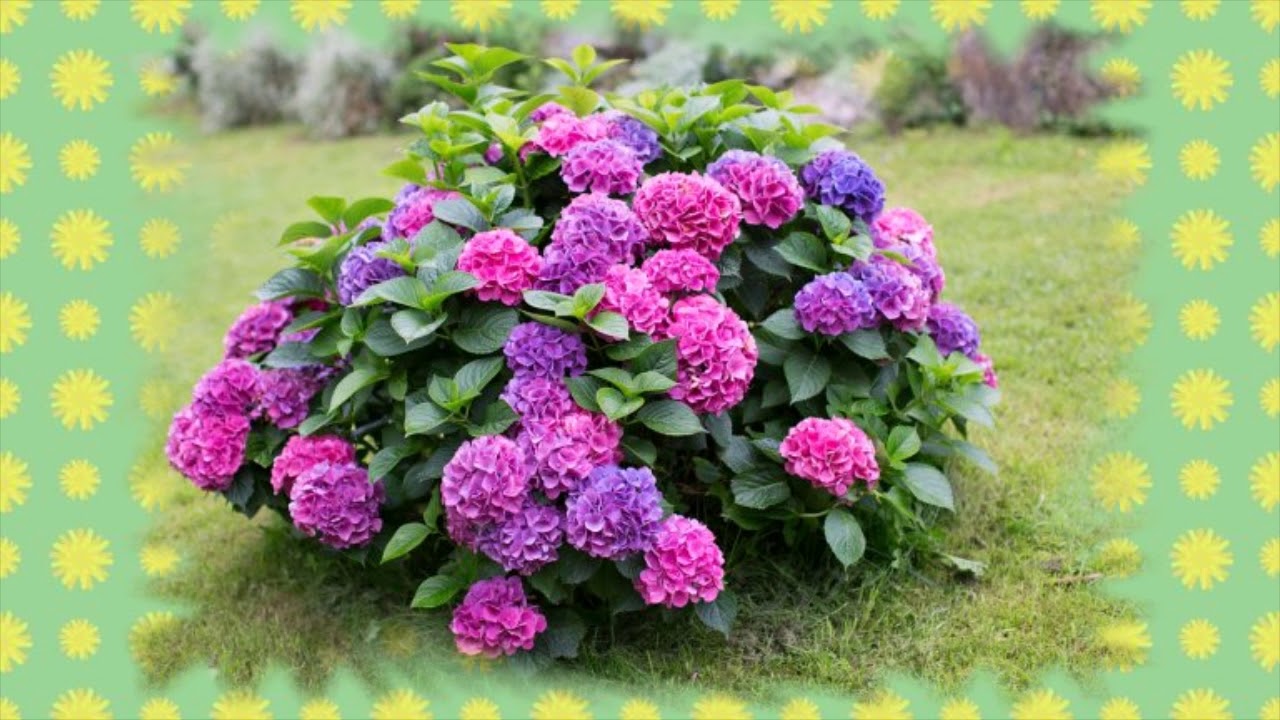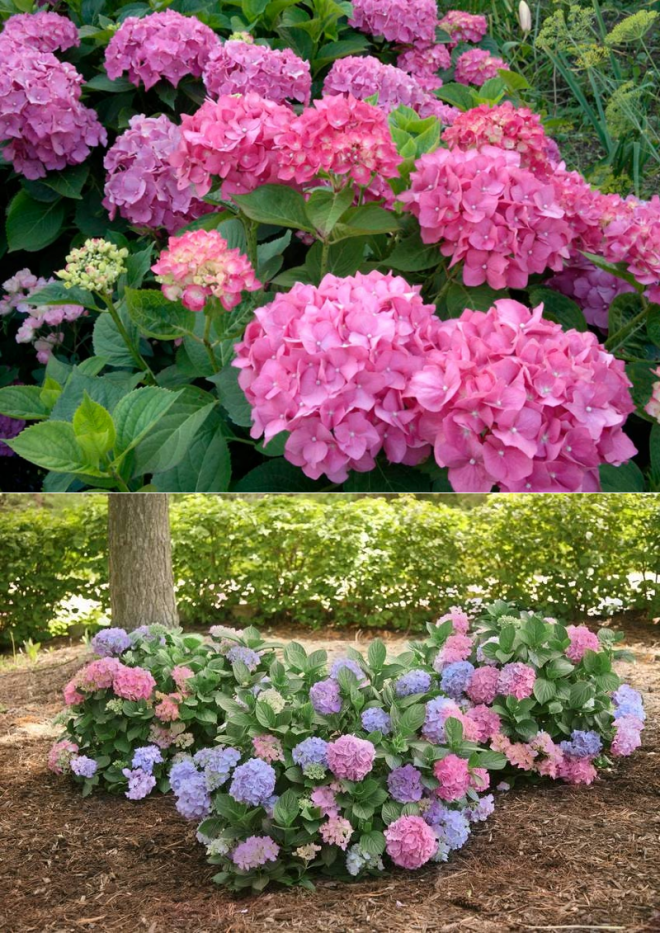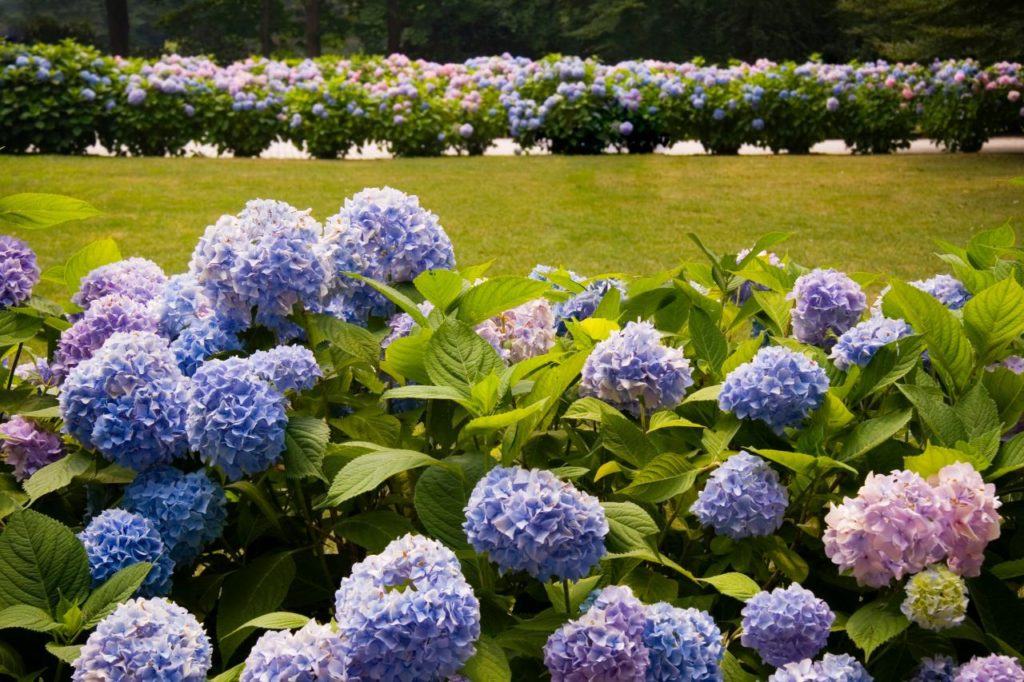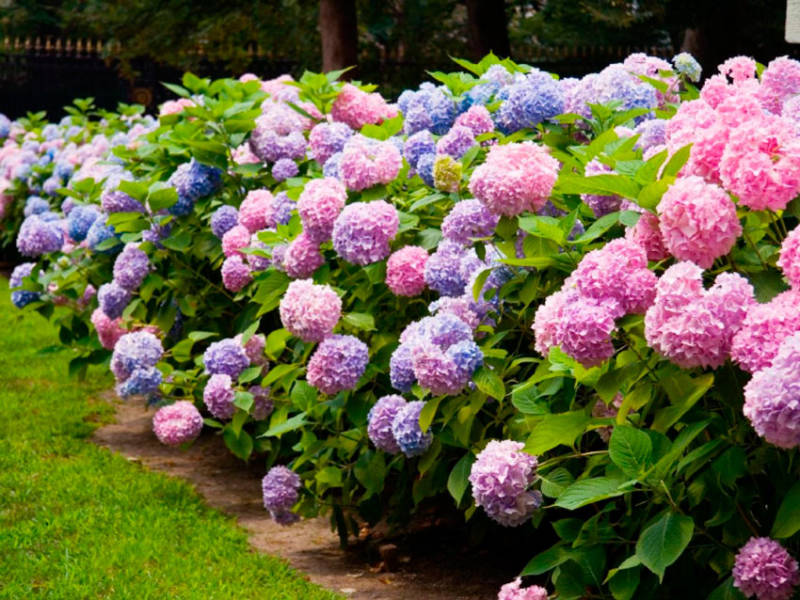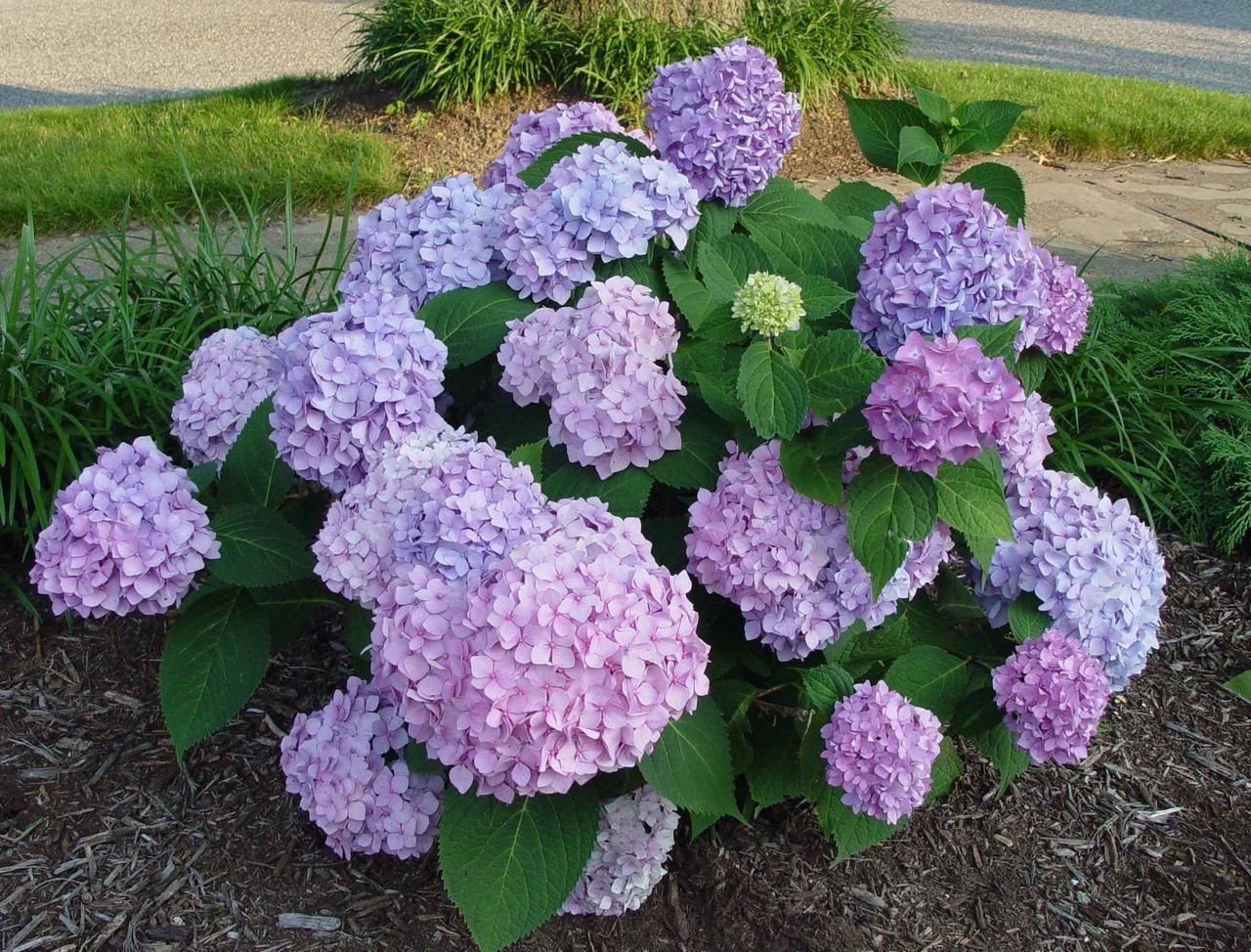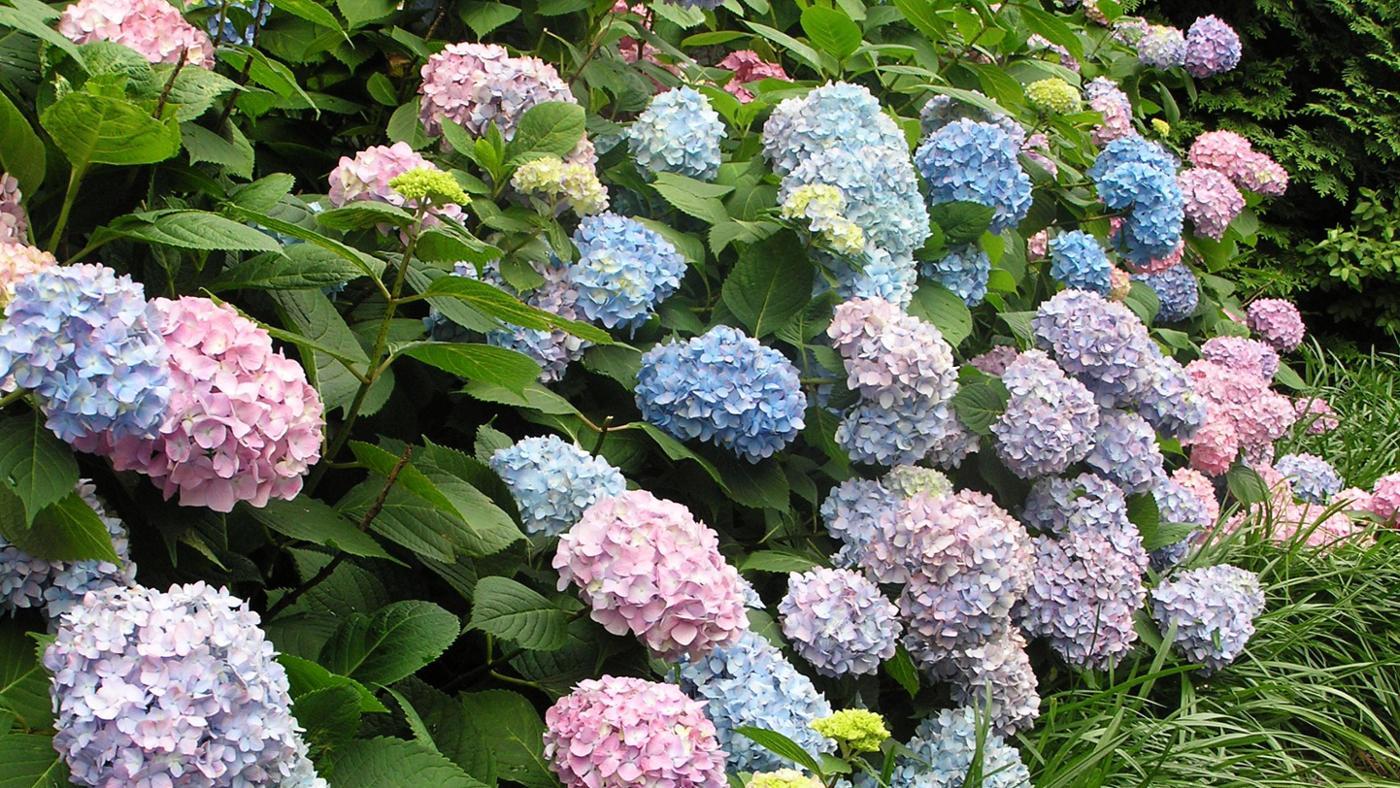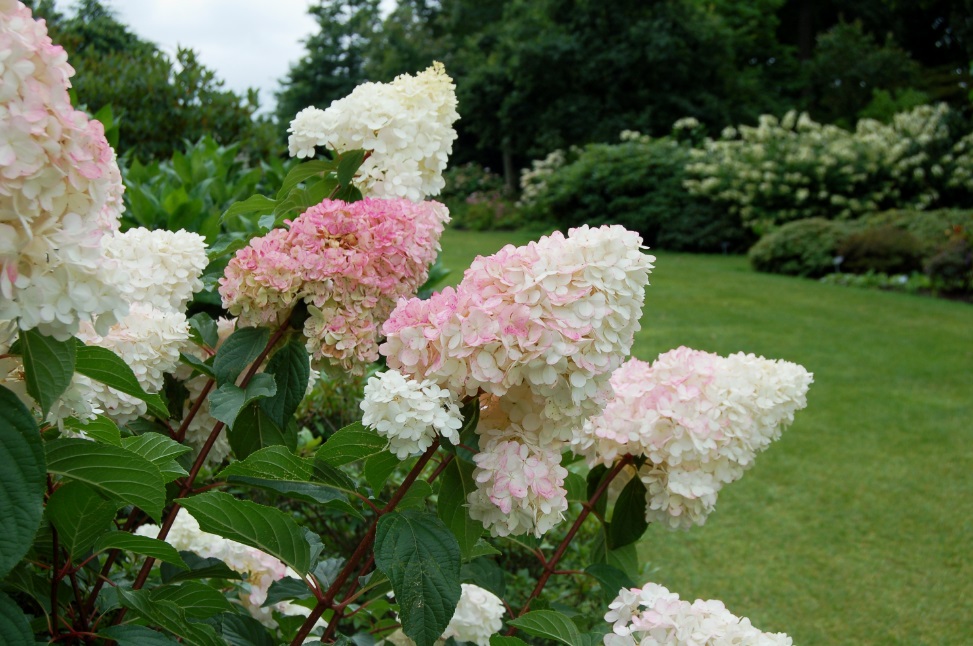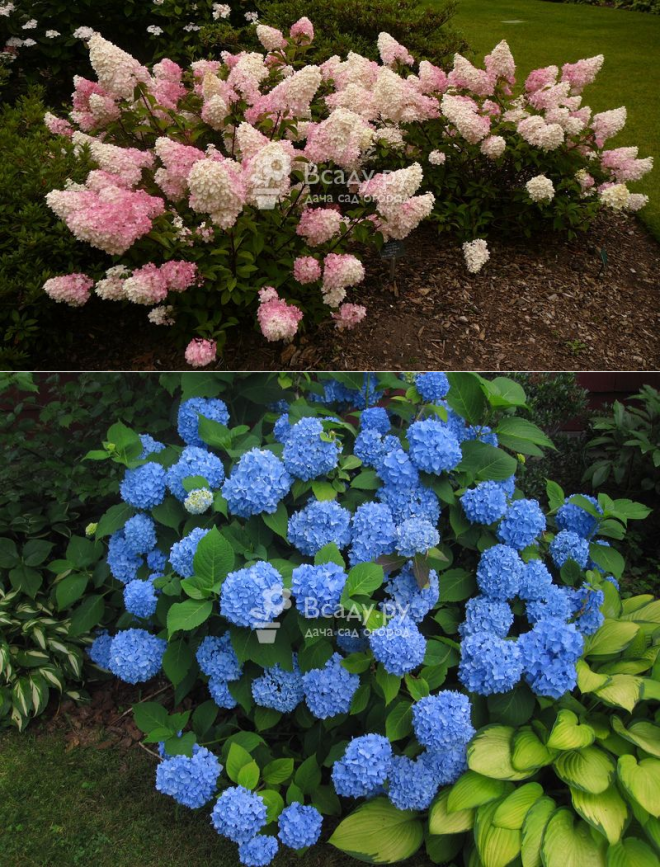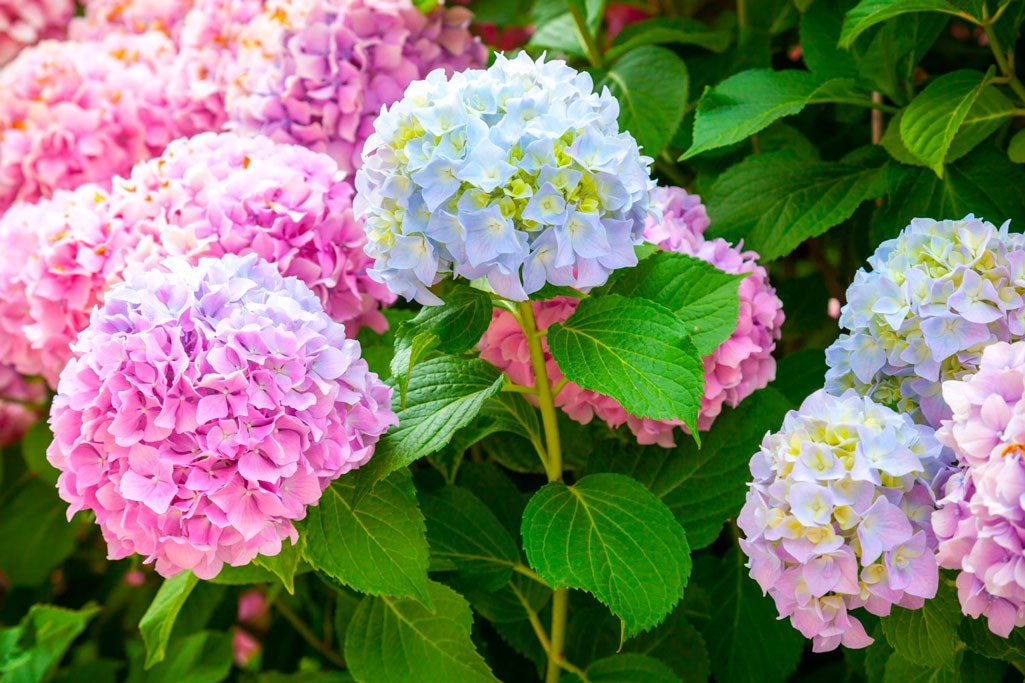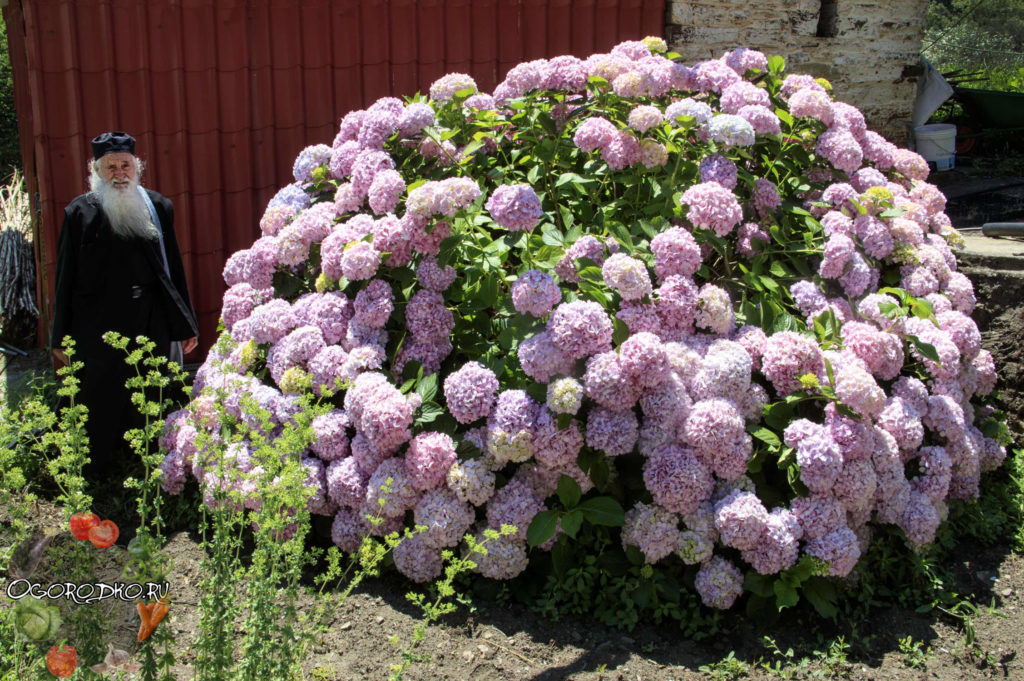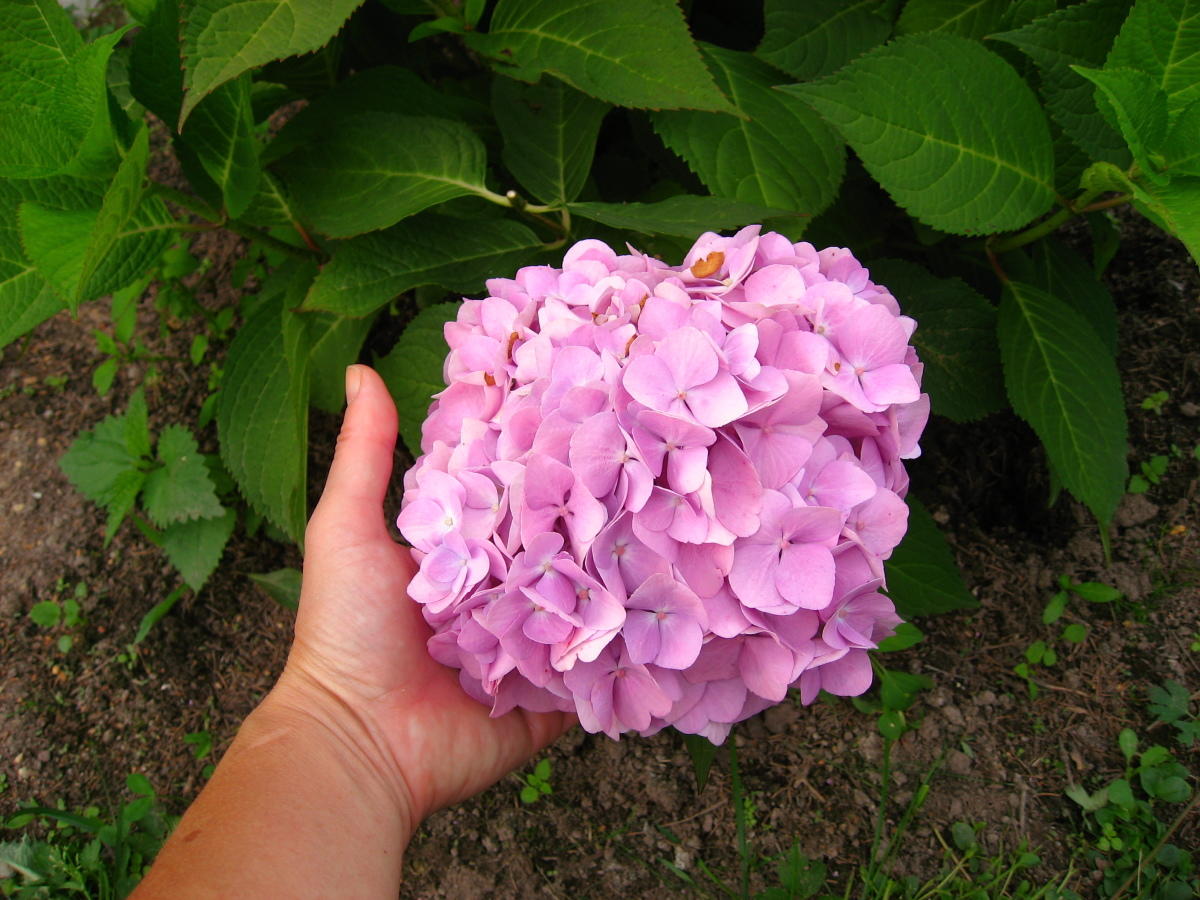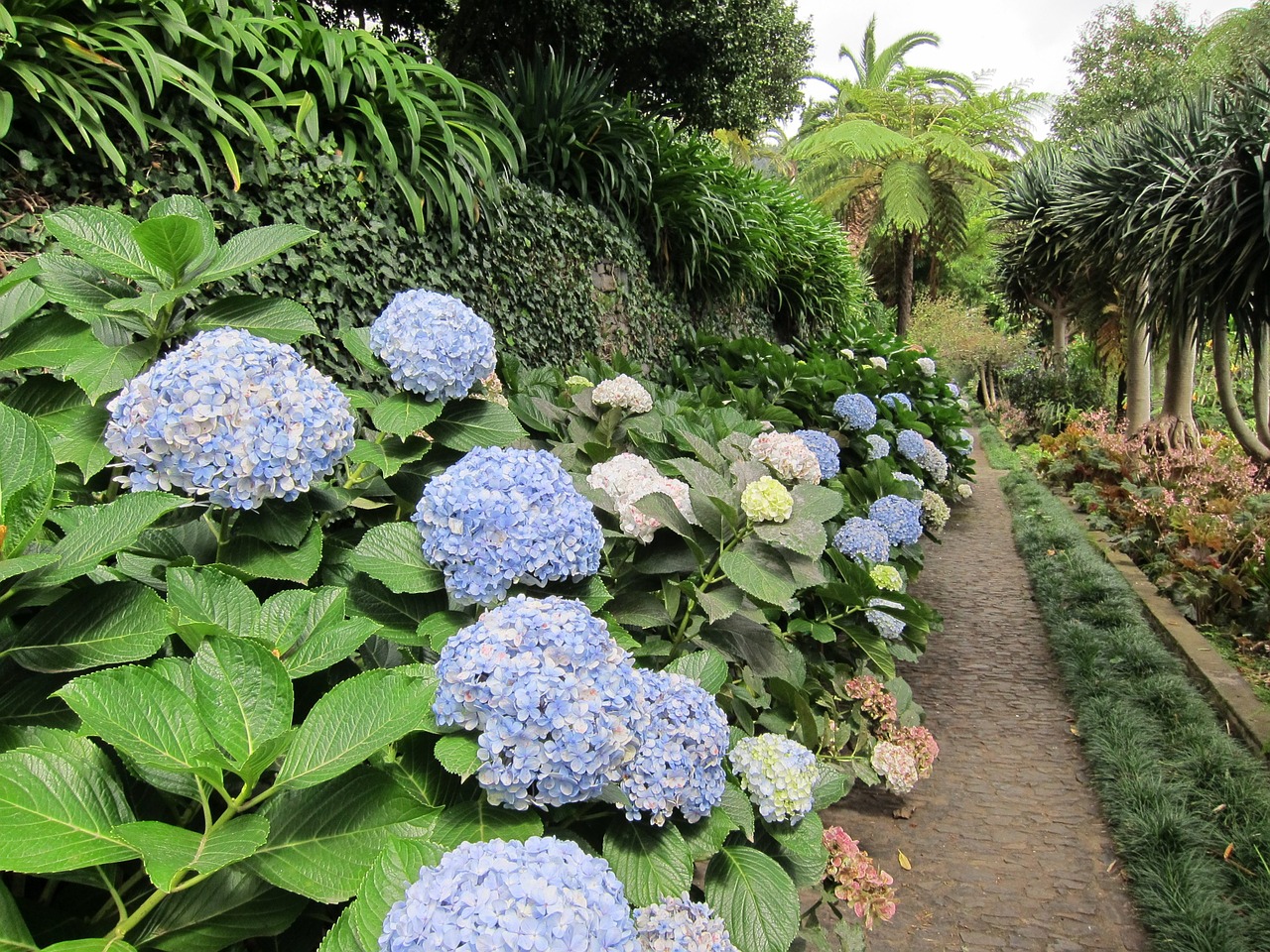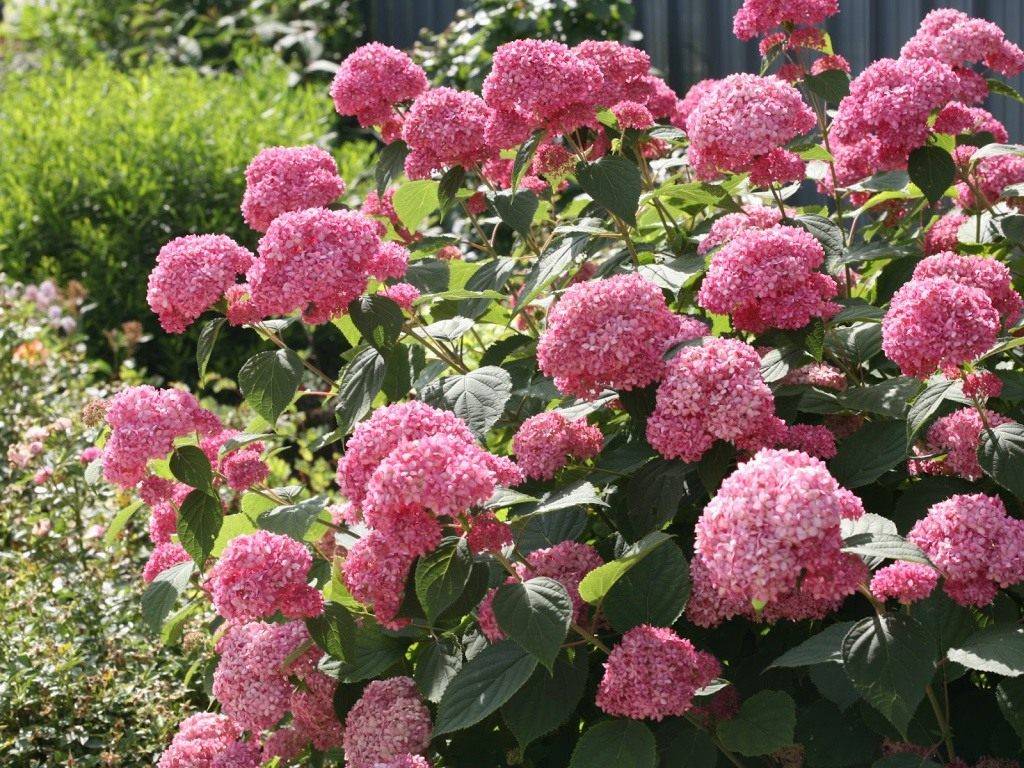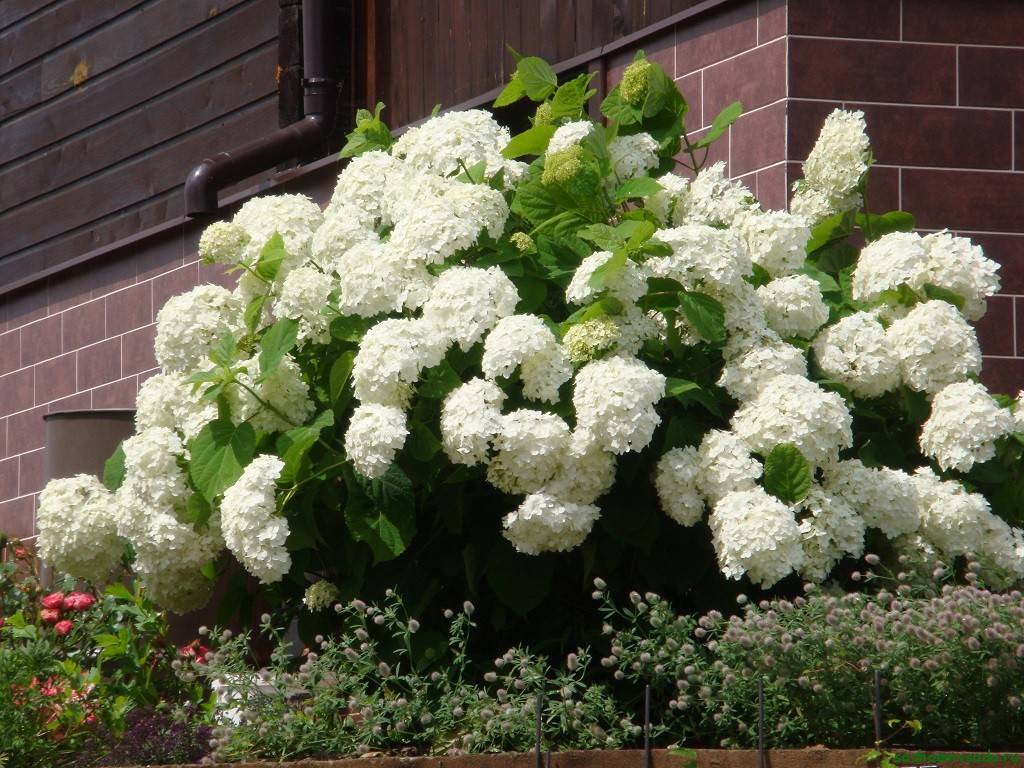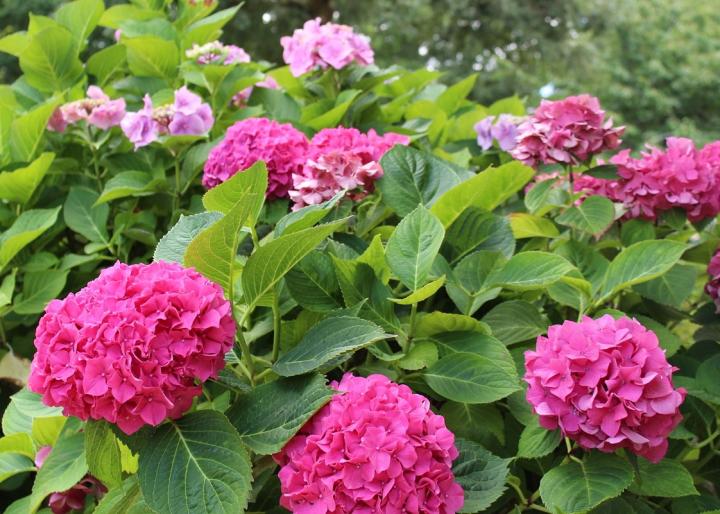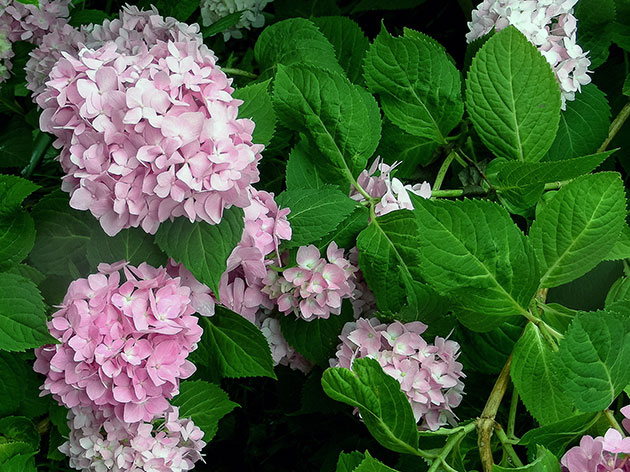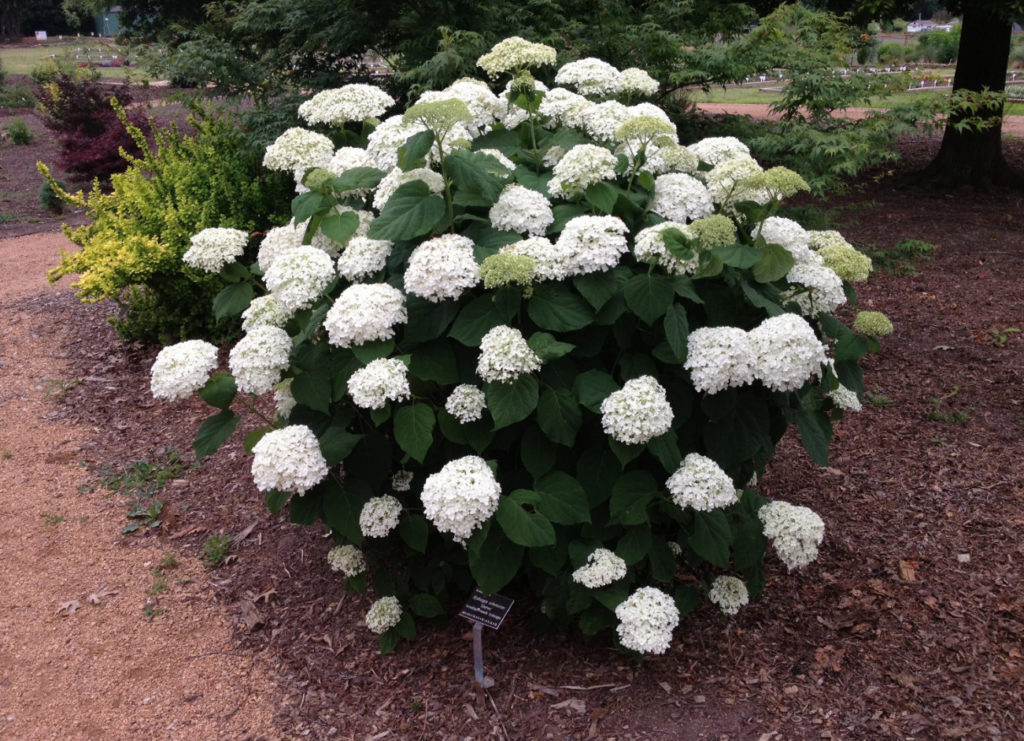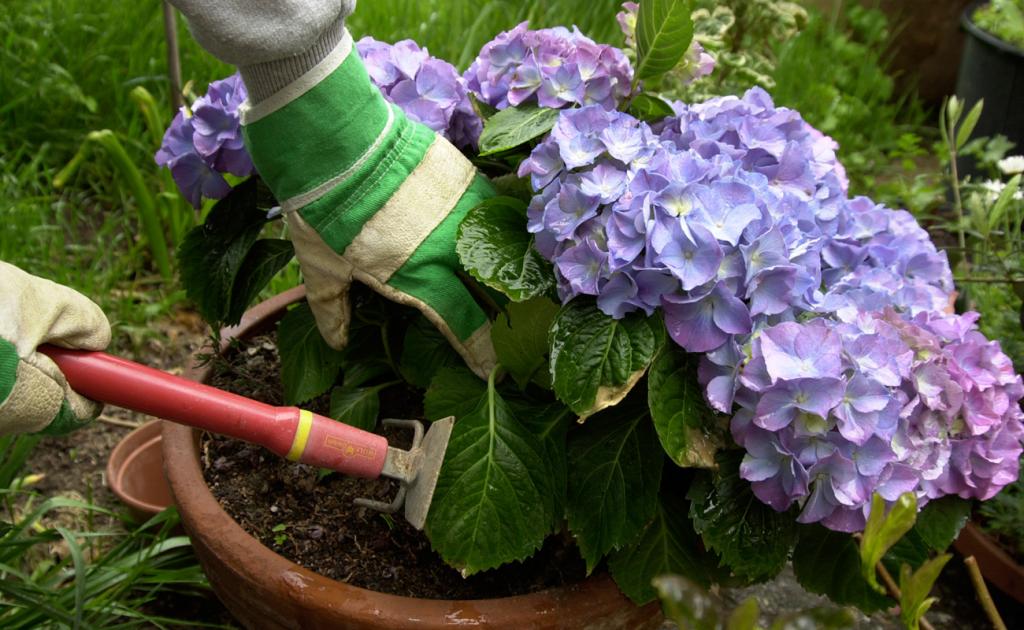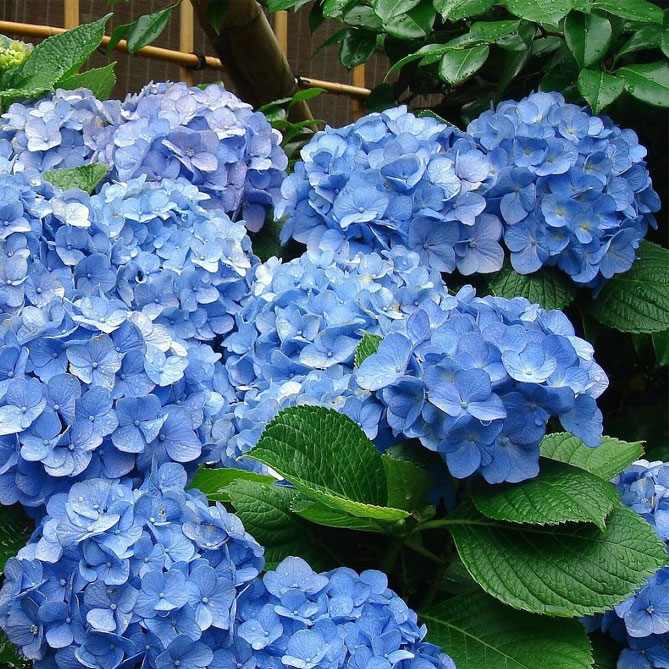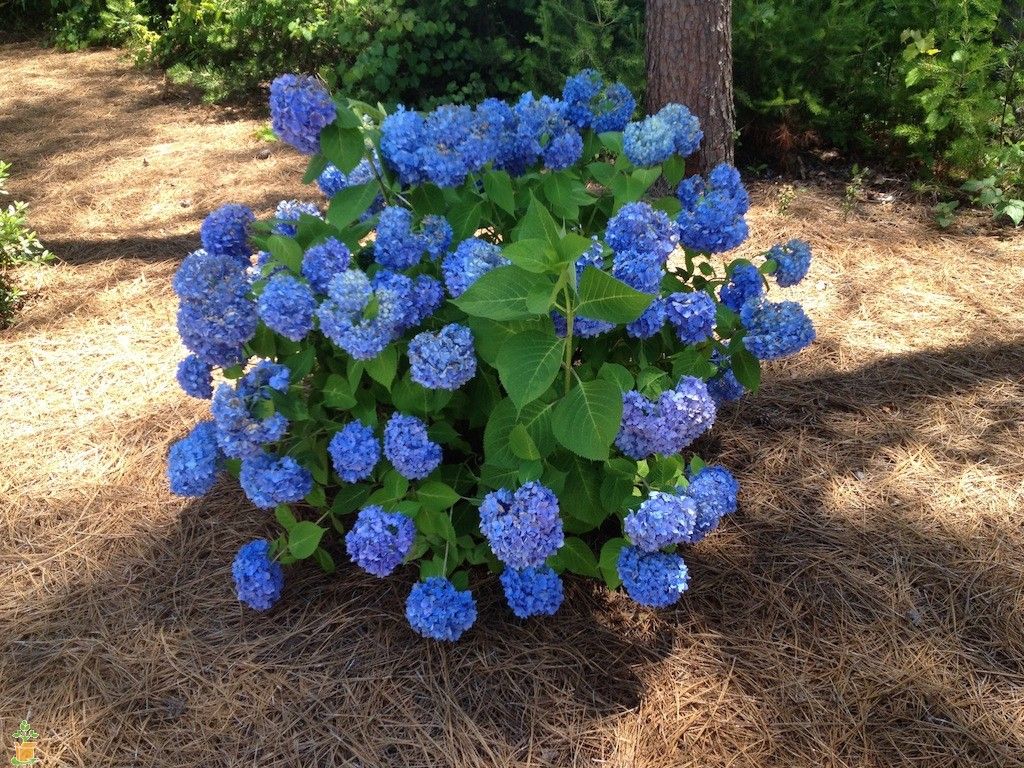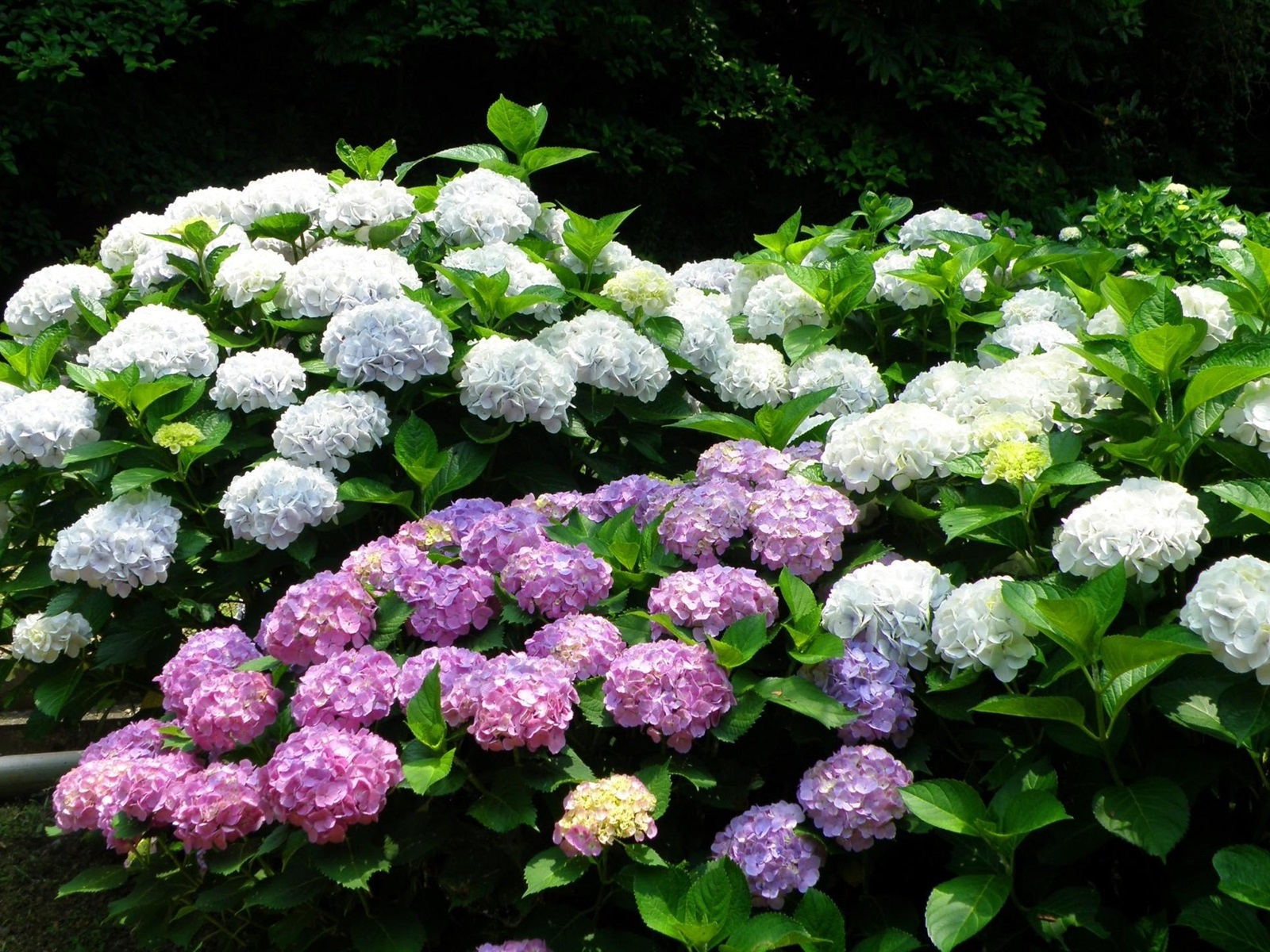Watering
Many novice flower growers dream of beautiful plants in their plots, as in the photo. Planting a garden hydrangea and caring for it in the future is not difficult. And yet it must be remembered that for the plant to bloom abundantly, it must be regularly watered. It should receive a lot of moisture, especially if it is in a sunny place. To ensure continuous flowering in July, you can make a third top dressing in the form of humic or phosphorus-potassium fertilizers.
Hydrangeas are very sensitive to watering. It is better to use warm water to moisten the soil. The plant does not like drought, so it needs to be regularly watered. Slight drying of the topsoil is acceptable, but no more.
Experts recommend using only soft water for irrigation. It could be rainwater. You can also use tap water, but then it will have to be defended for five days. The sensitive root system of hydrangea does not like low temperatures, so water is suitable for irrigation, the temperature of which is above + 15 degrees. On average, at least 16 liters of liquid per week must be poured under each bush. Watering should be done in the evenings or early morning.
Hydrangea paniculata
This hydrangea can be called one of the most beautiful species. These are small trees that rarely exceed 10 meters in height. It is often found in China and Japan, in Russia it feels good on Sakhalin. Hydrangea leaves are elliptical in shape, their average length is 12 centimeters. Hydrangea flowers form large panicles, they are characterized by an incredible sweet aroma, therefore they are excellent honey plants
It should be noted that such a hydrangea grows very quickly, it requires constant pruning.
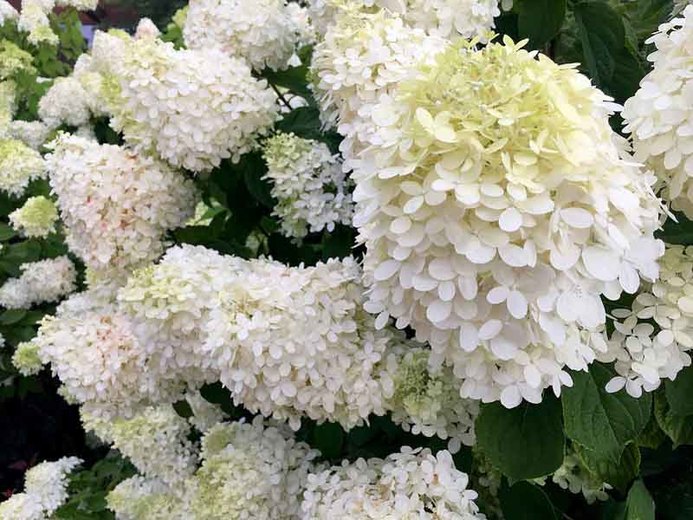
It is recommended to grow panicle hydrangea in a shady place. The thing is that in direct sunlight, its inflorescences become small. Plants should also be protected from the wind. In the event that you follow all the rules for caring for hydrangea, you will have a long and lush flowering, which will begin in June and last until October. Panicle hydrangea is frost-resistant, it easily tolerates winter with cold snaps down to -25 degrees. Therefore, such a plant can be grown in the central and northern parts of Russia. Speaking about how panicle hydrangea looks like, it should be said that all varieties are different from each other. Let's consider the most popular ones.
How to feed hydrangea
The first feeding of white hydrangea begins with awakening from the winter rest, characterized by sap flow and the opening of the first buds. Organic or mineral fertilizers are applied after abundant watering in order to avoid a chemical burn of the root system.
Excessive enthusiasm is caused by the irrepressible flowering of the bush. Thin branches break off under the weight of large inflorescences. During the period of growing green mass and during flowering, the plant needs different microelements.
 Wood ash solution is contraindicated for hydrangeas, as it alkalizes the soil. From early May to mid-June, hydrangeas are fed with a complex with a predominance of nitrogen. Potash fertilizers are applied throughout the summer to maintain the flowering phase. Since the beginning of September, hydrangeas have not been fed, so as not to provoke growth. In mid-September, watering is reduced as the plant prepares for the winter dormancy phase.
Wood ash solution is contraindicated for hydrangeas, as it alkalizes the soil. From early May to mid-June, hydrangeas are fed with a complex with a predominance of nitrogen. Potash fertilizers are applied throughout the summer to maintain the flowering phase. Since the beginning of September, hydrangeas have not been fed, so as not to provoke growth. In mid-September, watering is reduced as the plant prepares for the winter dormancy phase.
How to deal with pests and diseases of hydrangea
Most of the cultivated varieties are resistant to diseases, rarely attacked by insects. But it is advisable to know the methods of dealing with those and others:
- Downy mildew, powdery mildew. The solution to the problem will be to sprinkle the bush twice with an interval of 10 days with a Bordeaux mixture of 3%.
- Chlorosis. A solution of ferrous sulfate in a proportion of 10 g / 10 l of water will help to cope with the misfortune. In case of severe damage, the concentration should be 50 g / 10 l.
- Tracheomycosis. Watering the soil and spraying with an aqueous solution of the fungicide "Maxim" 2 ml / 10 l is an effective way to fight the disease.
- Gray rot. The drug "Alirin-B" will come in handy. It is necessary to dissolve 2 tablets in 1 liter of water and treat the bush with this composition.
- Root nematode. "Bazudin" in granules is embedded in moist soil at a rate of 1.5 g / m². Thus, you can get rid of the pest.
- Spider mite. The drug "Actellik" will help to cope with the problem. The spray solution is prepared in a ratio of 2 ml / 2 l of water and then the plant is treated.
- Aphid, leafworm. To fight, use the "Akarin" remedy. 2 ml of the preparation is dissolved in 1 l of water and the ground part of the flower is treated.
- Slugs. The shellfish are harvested by hand. Broken nutshells scattered on the ground will help prevent the appearance.
Growing at home

As already mentioned, panicle hydrangea is not particularly whimsical. Planting and caring for it does not require much effort, so even beginners who have never had indoor or garden flowers before can cope with everything. But in order for it to grow well and delight with its beauty, it is necessary to follow a number of rules. Here are the main ones:
- Hydrangeas belong to the group of moisture-loving flowers, so they need regular and abundant watering.
- It is not recommended to feed them with organic fertilizers, as they may prevent the plant from blooming.
- If you grow your hydrangea outdoors, you should prune it every year. It is needed not only to give the shrub a better decorative effect, but also to rejuvenate it.
- For the winter, flowers must be covered. If this is not done before the onset of the first frost, then the root system may suffer, which is fraught with the death of the flower. This also applies to frost-resistant species.
- If you want to make a landscape design in your garden and plan to create a flower arrangement in it, then take a responsible approach to the choice of soil. By varying the acidity, you can get flowers in any shade you want.
- Many novice growers who do not know when to plant a hydrangea and how to choose the right place for planting it make the same mistake. They do not take into account that this species is very fond of warmth. Shrubs will feel best on the south side of the house in partial shade. This will provide them with sufficient heat and will not be affected by direct sunlight.
The great advantage of hydrangeas is that they are highly resistant to diseases and harmful insects. With proper watering and timely application of fertilizers to the soil, there are no problems with leaving.
Wintering garden hydrangea
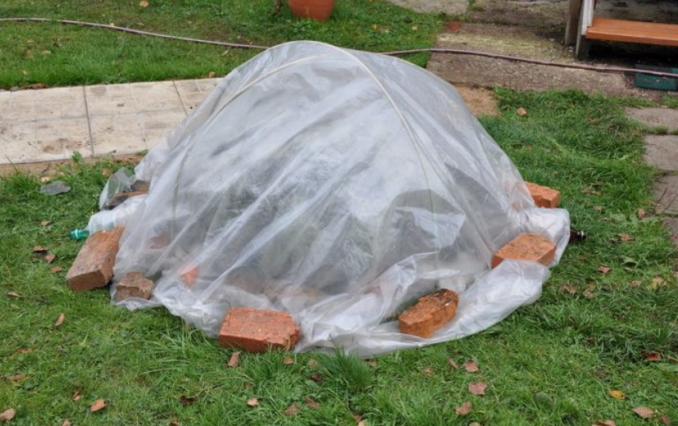
The most important disadvantage of garden hydrangea is low winter hardiness: its annual shoots, in the upper part of which flower buds are laid in autumn, never ripen by autumn and go green for the winter. These buds, either in early cold autumn, do not mature at all (in the north), or die without special shelter due to severe winter frosts (below minus 18 ° C in the middle lane) or return spring frosts. As a result, even heavily frozen shrubs restore the aboveground part by summer and, alas, do not bloom. In order not to be disappointed in hydrangeas after the first non-flowering, you can plant decorative leaf specimens ("Maculata", "Tricolor", "Quadricolor"), which, even without flowers, will become an original decoration of the garden, but absolutely everything for growing flowering plants in our climatic conditions varieties need to be covered annually for the winter.Of course, in a common mixborder, the shelter, which will be completely removed only by mid-late May, will not look very representative, and the organization of wintering for hedges can be too troublesome, but, as connoisseurs of hydrangeas assure, the luxurious flowering of this shrub is worth such " victims ". In order to make it easier to organize a winter shelter, it is better to plant the hydrangea separately from other flowers (on the lawn), but if the size of the site does not allow, you can plant it in a tub. Such a planting is good in that the plant can be painlessly transferred in order to better choose the illumination for it, the color scheme of neighbors, organize wintering (under cover or in a greenhouse) and it is necessary to ensure the optimal composition of the soil. This method is the best suited for the climate of the middle zone, where most varieties are generally recommended to be grown, like poorly hibernating chrysanthemums - with wintering in a cellar (no higher than +6 ° C) and planting in the ground in late spring after return frosts.
Freedom
The description of the hydrangea, whose name translates as "freedom", is amazing. Just imagine: the petals of a plant of this variety can change their color! Initially, it is pale pink, but over time it becomes ultramarine. A white border remains on the edges of the petal, which looks just amazing. Add to this the malachite hydrangea leaves ... Photos are not able to fully convey the beauty of the plant. It is no surprise that gardeners from all over the world grow the Freedom hydrangea in their gardens. Its advantages include not only a magnificent appearance, but also the strength of the shoots, which, even in the strongest wind, will not break under the weight of the inflorescences.
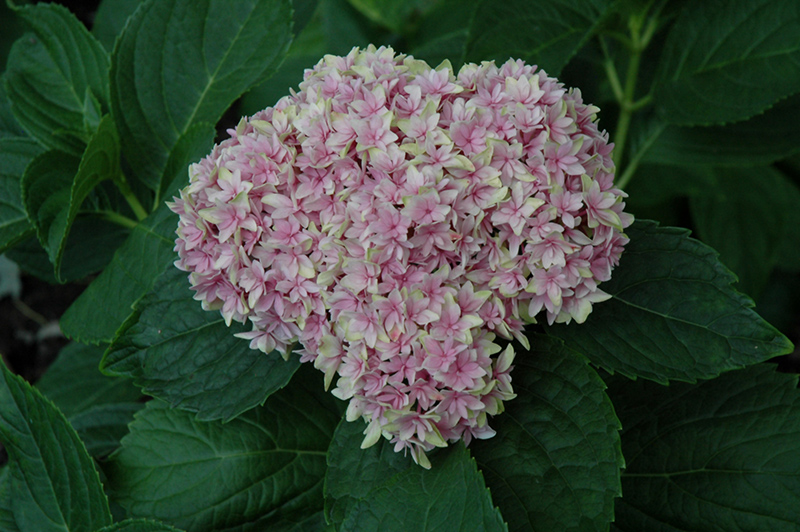
Popular types
In nature, there are about 80 species of wild-growing hydrangeas, some of them have been improved by breeders and are suitable for growing in the garden and for decorating the urban landscape. Consider the main types of graceful plants.
Large-leaved
The lush shrub is most popular with gardeners. This type of hydrangea forms charming lush inflorescences-balls. Large-leaved hydrangea is characterized by weak frost resistance, requires shelter for the winter and careful care. Needs regular watering and sanitary pruning.
Paniculata
It differs from the large-leaved hydrangea in the shape of the inflorescences, it is cone-shaped. Blooms from July to October. Suitable for creating dry winter bouquets. In landscape design, it is used to design areas of reservoirs. Less demanding for systematic care.
Pereshkovaya
Type of climbing hydrangea. It can reach a height of 10 meters, suitable for decorating gazebos and terraces. Differs in high winter hardiness and exquisite aroma during the flowering period.

Tree-like
The plant is native to North America. Unpretentious in cultivation, forms spherical inflorescences. Needs regular pruning, winters well, forms a spreading bush about 2 meters in diameter.
Groundcover
Ornamental shrub of the creeping type. Plant height - no more than 30 centimeters. Average winter hardiness, used to decorate vertical surfaces or alpine slides.
Dubolistnaya
Deciduous shrub up to 2 meters high. It differs in the original shape of the leaves, reminiscent of leaf plates of oak or maple, which in autumn change color from green to red-brown.
Hydrangea
This type of hydrangea is also known as wild and smooth. The plant is quite unpretentious, refers to frost-resistant. That is why it is grown with great pleasure by gardeners in the middle latitudes of Russia. Treelike hydrangea does not need shelter for the winter, it is unpretentious to the ground. But what the plant does not tolerate is drought and excessive amounts of sunlight: hydrangeas require abundant watering and a partial shade area.If all conditions are met, flowering will begin in June and continue until the end of September. The average height of the bush is about two and a half meters. Stems are straight, bare. What do hydrangea leaves look like? In the photo below, you can examine them in detail. Well, right now we bring to your attention the main varieties of hydrangeas of this type.
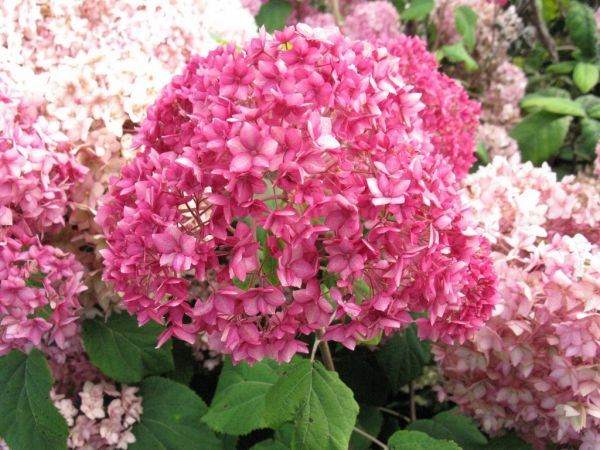
Hydrangea radiant
This hydrangea has an extremely low frost resistance, and therefore is rarely used to decorate gardens in Central Russia and the northern regions. But in the south, this plant feels just fine. Radiant hydrangea is a shrub that usually reaches two meters in height. Leaves are oval, lanceolate, pointed. A huge number of snow-white flowers are collected in small shields. Note that flowering begins in July and lasts only a month. Even in the southern regions of our country, it is recommended to cover the roots for the winter with dry foliage, spruce branches. It is distinguished from other representatives of the hydrangea family by its incredibly fast growth rate.
The best place to plant hydrangeas
The success of growing hydrangeas largely depends on the right place. The shrub prefers a cozy and calm place, without drafts. Hydrangea is grown in partial shade to prolong flowering. When choosing a site for planting hydrangeas in the fall, you need to take into account the size of the bush. An adult plant grows up to 3.5 meters in height and about 1.5 meters in width.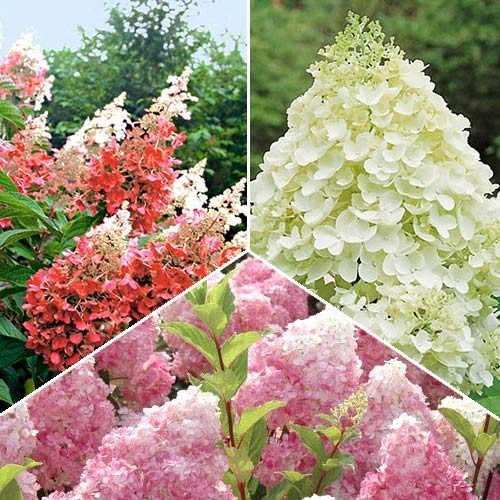
An important factor in growing hydrangeas is the soil. The shrub prefers light and nutritious mixtures. Preparing the soil must be done in advance. Hydrangea belongs to moisture-loving plants, so the soil must be moisture-consuming. Adding humus, leafy earth, sand and peat to the mixture will help to enrich soil that is too poor in composition. In order for the substrate for planting to have all the necessary nutrients, superphosphate, urea and potassium sulfate are added to it.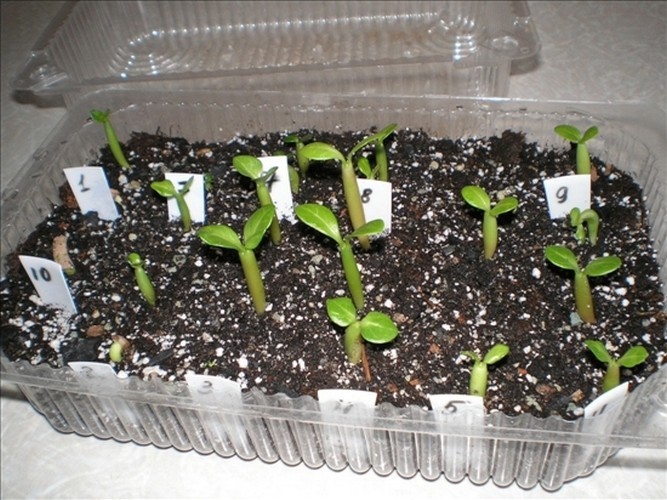
How to properly plant a hydrangea in the garden
An ornamental perennial shrub grows beautifully in quiet corners of the garden, open to the sun in the morning. Despite the fact that hydrangea does not tolerate a lack of moisture, wetlands should be avoided. It is also highly undesirable to plant the plant in poor sandy soil that is rapidly losing moisture.
When choosing a permanent place for hydrangeas, you should choose closed corners protected from drafts and winds. The nearest building or fence should be removed at least one and a half to two meters. The planting of the specimen is carried out in the off-season. The rules for spring and autumn planting of hydrangeas have significant differences and require additional study.
Description of garden hydrangea
The undoubted queen of the garden pleases with a generous annual flowering. Landscape designers willingly use a variety of types of hydrangea to compose flower beds. The garden perennial is widely represented by almost 80 varieties.
Among others, varieties have gained particular popularity:
- White Anna.
- Annabelle.
- Grandiflora.
- Invincibel Spirit.
- Sterilis.
- Vanilla Fraze.
- Limelight.
- Pinky Winky.
It should be noted that hydrangeas easily change varietal colors when the acidity of the soil changes in one direction or another. Most of the species are flowering garden shrubs. Breeders have made an effort to stabilize and fix the specific color of the spherical inflorescences for the species.
Varieties with white flower caps look especially elegant and solemn in any weather. Garden hydrangea grows well in one place for no more than ten years.
In natural conditions, there are tree-like, liana hydrangeas. Shrub species are the most widespread. In the wild, the height of perennials often reaches three meters.
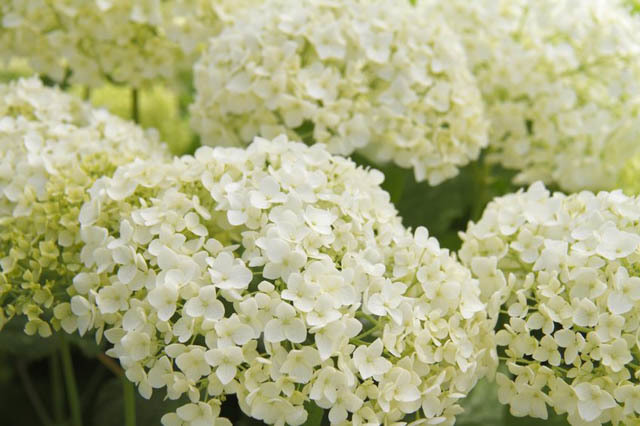 However, the domesticated species are significantly shorter than their wild counterparts. Garden varieties of hydrangeas rarely exceed a person's height.Deciduous shrub has a fibrous root system. Large pointed oval leaves are located opposite each other on the branches. The edges of the leaves are serrated with pronounced veins. Flowering lasts from mid-spring until the first frost.
However, the domesticated species are significantly shorter than their wild counterparts. Garden varieties of hydrangeas rarely exceed a person's height.Deciduous shrub has a fibrous root system. Large pointed oval leaves are located opposite each other on the branches. The edges of the leaves are serrated with pronounced veins. Flowering lasts from mid-spring until the first frost.
Small flowers are collected in large spherical clusters of inflorescences. Usually flowering buds awaken on the shoots of the last year. A wide range of colors is characteristic: from pale pink and deep purple to pale blue and bright purple. In most cases, soil pH will affect the color. Acidic soil enhances the blue spectrum, while alkaline soil exhibits pink tones. White caps of hydrangea flowers indicate neutral acidity.
Invincibelle Spirit

Gardeners call this variety a real innovation in the field of breeding. In our country, he appeared quite recently, but has already managed to win the hearts of thousands of gardeners. The name of the variety can be translated as "invincible spirit", which is a fairly accurate characteristic of the flower itself, which has collected all the virtues of the best representatives of hydrangea. The plant is resistant to various diseases, has increased frost resistance, and its inflorescences look just incredible: flowers are formed on the bushes that have a rich dark pink color, which eventually turns into bright pink. Speaking about how a hydrangea should look after winter, flower growers note that even after cold temperatures of -37 degrees, the plant quickly recovers, forms new shoots and flowers.
How is hydrangea propagated?
Beautiful photos of garden hydrangea flowers will not leave anyone indifferent. Every gardener wants to plant wonderful plants in his area. How does hydrangea breed? You can grow a new bush using cuttings, seeds, by dividing the bush or layering.

Using seeds for propagation is a very simple way. The seed is planted in open ground in March without prior stratification. Unfortunately, this is not the fastest way. It will take a very long time to wait for plants grown from seeds to bloom.
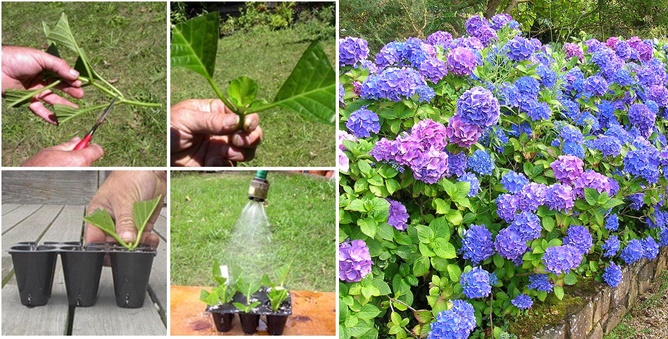
To quickly get an excellent result, it is worth propagating the bushes by cuttings. To do this, in the summer, shoots are cut, on which there are two pairs of leaves. The length of the branches should not exceed 17 cm. On the cuttings, oblique cuts are made, located one centimeter below the buds with leaves. From below, they are powdered with rooting amplifiers, and then they are planted in containers with a light substrate. The cuttings are covered with a greenhouse on top, and the pots themselves are placed in partial shade. On average, the rooting process takes up to 6 weeks. Caring for cuttings is quite simple. It consists in regularly moistening the soil and ventilating the greenhouse. It is possible to remove the shelter only after the appearance of young strong shoots. Hydrangeas obtained from cuttings will bloom next year.
The fastest and easiest way to propagate hydrangeas is by dividing the bush. Sometimes the culture is bred using layering. To do this, shoots, which are more than a year old, are added dropwise, leaving a part on the surface. In the fall or spring of next year, the branches are separated from the mother bush and transplanted to a new place. Hydrangeas are practically not propagated by grafts.
Serrata hydrangea
The height of this tree-like shrub is within one and a half meters. The crown is spreading, the leaves are oval, bright green. The serrated hydrangea is an annual. The inflorescences resemble a ball. In the center, the flowers have a blue tint, but closer to the edge they become pale, almost white. When the inflorescences fade, the petals take on a pinkish tone. Flowering continues from July to September, at which time the plant needs moderate watering.
Speaking about the characteristics of this hydrangea, gardeners note that it is absolutely unpretentious in care, is not afraid of the most common diseases and pests.It can be planted even in the Middle Lane, but at the same time it is necessary to properly prepare it for winter: all wilted inflorescences must be cut off, and then the plants must be covered with foil.
Hydrangea planting from seeds
The soil for hydrangea should contain sand, peat, turf, leaf or coniferous soil, humus. If you don't have all the ingredients, dig up forest soil or harvest from a molehill. With the mass reproduction of hydrangeas, planting is carried out in wooden boxes, then covered with glass.
Fresh articles about garden and vegetable garden
Growing gladioli outdoors
Pansies: growing from seed, when to plant?
Barberry: planting and care in the open field, photo
If in a flower pot, then cover the sprout with a jar. Let's consider sowing in more detail. To get a lot of seedlings, take a large wooden box up to 15 cm deep. Scatter the soil, leaving 3-5 cm of loose sides. Sow dry seeds directly on the ground without further digging into the soil or covering. 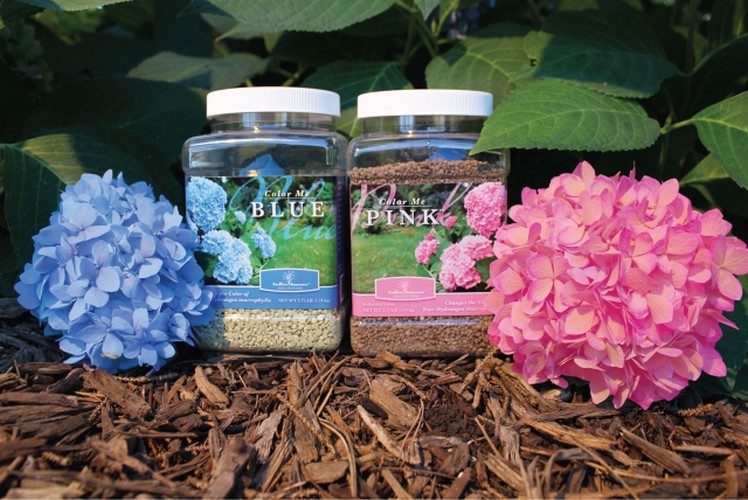 Pour generously with water from a watering can and cover with glass or plastic. As soon as the first shoots appear, remove the film. During this time, monitor the moisture content of the soil and periodically ventilate the ground. In the same way, they sow hydrangea in flower pots, only instead of a film they use a jar. By the way, cuttings are also placed in a jar at room dilution. For germinated or dry seeds that are planted in open soil, dig up a small bed. Dry seeds are scattered randomly, then trampled down and sprinkled with sand or a layer of earth by 1 cm. The sprouted seeds are gently immersed in the soil to a depth of 1 cm, and are also sprinkled. Landing in gardens is carried out in well-warmed soil, the optimal time is May-early June. The first leaves will appear in 3 weeks - a month.
Pour generously with water from a watering can and cover with glass or plastic. As soon as the first shoots appear, remove the film. During this time, monitor the moisture content of the soil and periodically ventilate the ground. In the same way, they sow hydrangea in flower pots, only instead of a film they use a jar. By the way, cuttings are also placed in a jar at room dilution. For germinated or dry seeds that are planted in open soil, dig up a small bed. Dry seeds are scattered randomly, then trampled down and sprinkled with sand or a layer of earth by 1 cm. The sprouted seeds are gently immersed in the soil to a depth of 1 cm, and are also sprinkled. Landing in gardens is carried out in well-warmed soil, the optimal time is May-early June. The first leaves will appear in 3 weeks - a month.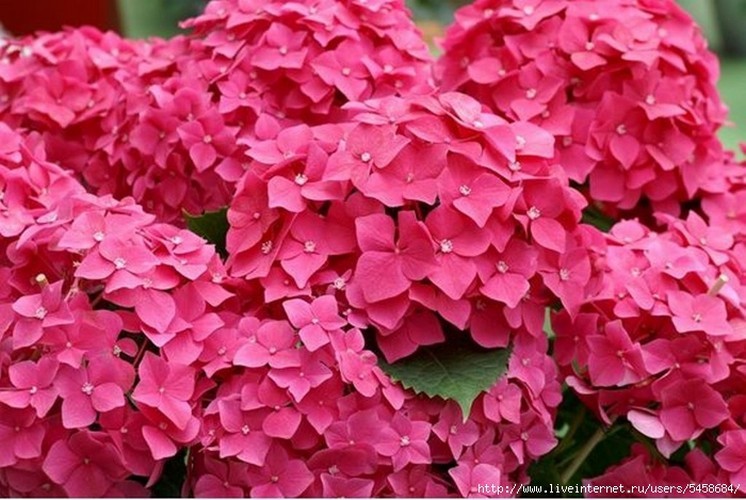
Planting through seedlings will accelerate the growth and flowering of the hydrangea. When the plant has produced two true leaves, plant the dense growth in the pots. As soon as the bushes have reached 7-10 cm, plant them in pots up to 10 cm deep or send them into open soil if it is spring outside the window.
Hydrangea oakleaf
This amazing two-meter perennial got its name from its appearance. The fact is that the leaves of the oak-leaved hydrangea are incredibly similar to the leaves of the oak. The flowers of such a shrub are white, collected in panicles. The flowering period begins in June and lasts until the autumn cold. Oak-leaved hydrangea prefers rich soils that are free of lime. Watering for them must be sure; plants must be covered for the winter. True, gardeners say that over time, plants become more resistant to cold weather.
Oak-leaved hydrangea can be propagated by cuttings, dividing the bush and layering, and twice a year - in autumn and spring - it is recommended to prune. Speaking about the varieties of oak-leaved hydrangea, gardeners distinguish two of the most beautiful:
- The Snow Queen. In late June or early July, this amazing shrub opens up its snow-white panicles. At the beginning of the season, the foliage pleases with a pleasant green color, but then becomes burgundy. Hydrangea of this variety looks great both in single plantings on the lawn and in large groups in combination with trees and shrubs.
- Snowflake. As the name implies, hydrangea varieties can delight with charming flowers shaped like snowflakes. At the beginning of flowering, they have a pleasant white tint, and towards the end they turn red-green.
Top dressing and fertilizers for hydrangeas
In the middle of summer, top dressing is necessary so that the inflorescences actively bloom and bloom for a long time. To feed the hydrangea during flowering, special complex fertilizers are used, for example, "Flower Kemira" (Fertika).
The dosage is 1 tablespoon per 10 liters of water.
Since the beginning of August, there should be no nitrogen in the composition of mineral dressings, which is due to two reasons:
This will contribute to a favorable wintering hydrangea;
Nitrogen increases the green mass and the size of the inflorescences.Due to their severity, the shoots can bend and even break, which will not add decorative effect to the bush.
It is recommended to alternate mineral fertilizers with organic fertilizers, such as a solution of poultry manure or diluted slurry. Hydrangea also responds to non-standard feeding.
Fertilizers containing nitrogen cannot be used in the fall. This mineral component stimulates the growth of shoots, which is not needed at this time.
New branches do not have time to ripen and can easily freeze over in winter, like the buds that were laid on them. As a result, the splendor of foliage and inflorescences next year will be much less.
It is also recommended to feed the hydrangea with organic fertilizers in the fall, for example, compost, peat, humus. To do this, they are laid out around the bushes with a layer of 5-10 cm. This will not allow the soil to freeze and will serve as a protection for the root system. Organic fertilizers will gradually decompose, giving the hydrangea nutrients.


